#because they were characterized so interestingly in that movie
Explore tagged Tumblr posts
Text
ya know for someone that doesn’t like the Smurfs I sure do make a lot of things about em…..or my favorite ones
#I think it’s because despite not liking them I grew up with them so there will always be some form of attachment#that and they’re relatable as f-ck sometimes#my stuffy stuff#the Smurfs#aka I’m thinking about the smurfs lost village and I’m obsessing over the boys and smurfette a bit#because they were characterized so interestingly in that movie#at least the way they were characterized intrigued me more the other adaptions#now if they’d remove the smurfette fawning and main characterness I’d be happy#you guys know what I mean don’t lie#it’s annoying#or maybe it’s just me#I always thought it was over kill#but I’m also glad she’s something other then girl#and remove the whole lost village is a BUTLOAD of girls I’d be happy too#cause that was dumb#don’t lie
1 note
·
View note
Text
Miraculous Movie Review (Rating: 4/10)
I watched the preview of the Awakening movie yesterday and really want to share my honest review. There’s going to be several things that I’ll criticize. So be warned!
Also: Spoilers!! DON’T read it if you haven’t seen it yet. This is my personal opinion. So please stay excited for it!! 🐞🪄

First of all, my overall rating for this movie is a 4/10. Just yesterday I was ready to give it a 5/10, but quickly noticed it had much more things that upset me than I initially realized when walking out of the movie.
I know it’s a pretty low rating coming from such a huge fan like myself, but that’s probably the main issue. I’m a big fan of the show, so changes in lore and characterization will be more apparent to me. For better or for worse, in this case, mostly for worse.
On the first glimpse the movie seems like a retelling - a soft reboot, if you will - of show’s origin story. The plot goes much further than that however, as it also provides a conclusion in form of a final battle with Hawkmoth as well as an identity reveal of our two main heroes.
In order to ensure the entire premise fits into a 90 minute movie, a lot of things regarding the shows lore were simplified. I say that as a neutral statement seeing as a simplification can be either a good thing or a bad thing, depending on your opinion of the source material.
Personally, it left me rather unsatisfied but I’m getting ahead of myself. Let’s start with the good things!
One of the things I really enjoyed was the animation! Seeing miraculous with such a high production value certainly felt like a cool summer breeze. While I do prefer the original character models style wise, it was still just nice to see them in this cutesie pretty style! The locals were gagging!
Ladybug and Cat Noir were especially gorgeous!
I also really enjoyed the singing. I watched the German dub and it was very neat!
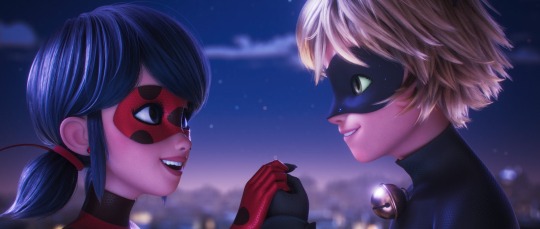
Sad to say that was pretty much how long my enjoyment lasted. Everything apart from what I’ve mentioned above was… interestingly handled… to say the least. Let me elaborate.
1. The dialogue was awful!
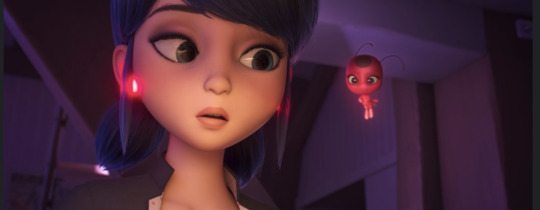
Truly not the biggest fan of musicals but I couldn’t wait for them to start singing just in order for them to STOP TALKING 😩!
The dialogue was so awkward and stiff. All of the characters were interacting very weirdly with each other. At times it would sound like several lines of dialogue were cut from the final version, as the characters barely acknowledged each other verbally. They didn’t talk with each other, but past each other.
Moreover, every second phrase was a very cheesy one liner. “Believe in yourself.”, “Listen to your heart.”, “stronger together”. Super overdone.
The movie wanted to be inspirational so bad, it forgot to be genuine.
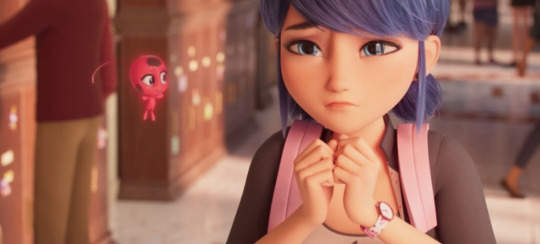
Some examples that I recall from memory:
“Mom, I don’t have any friends and I’m scared to go I school.”
“Just believe in yourself, Marinette.”
“Okay, thanks.”
Or.
“Tikki, I’m in love with Adrien.”
“Listen to your heart, Marinette.”
“My heart……Adrien.”
2. How did they manage to make Ladynoir banter … weird and uncomfortable to watch?
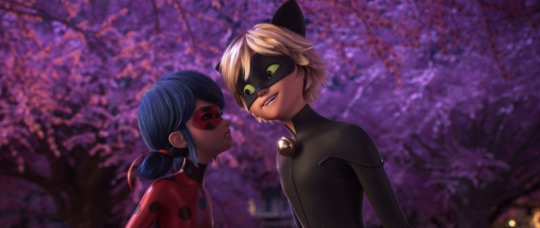
Don’t let these pretty movie shots fool you because Movie!ladynoir spent their time in a constant roasting competition that they were somehow both losing!
Not once did they manage to establish that flirty and charming atmosphere around them. No, they were draaaagging each other through filth. And maybe it could have been somewhat fun, god knows I love couples that can roast each other. If only the dialogue was better and didn’t reek of “we have no idea how young people interact”.
In a desperate attempt to make jokes, they let Chat call LB a sidekick or watermelon in every. single. scene. To say that it got annoying when the jokes didn’t land the first 10 times they were made is an understatement. No Milady, no Bugginette, no little wink or a kiss on the hand. Only watermelon and sidekick. Them talking in weird cut off phrases. With careless whisper playing in the background.
Don’t get me wrong, there are some beautiful moments. But their beauty can only ever do so much when met with weird pacing, dialogue and characterization. I’ll talk about that last part in a minute.
3. Everything was so on-the-nose.
The characters would constantly say how they feel and what they think aloud. Jeremy didn’t trust us with even an ounce of media literacy. Classic case of always telling, never showing. Not to mention the constant inspirational quoting in a desperate attempt to convey some deep message. Is this a movie script or my moms facebook page? I guess we‘ll never know.
4. Characterization: Marinette
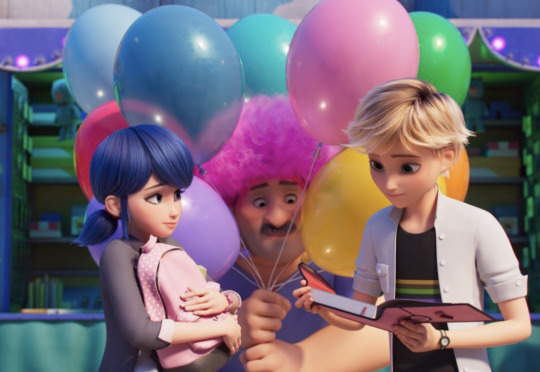
Having Marinette be somewhat scatterbrained but overall still respected by her peers is not inspirational enough! Make her your average teenage outcast and a total loser. Dad, you’re embarrassing me in front of the cool kids!
If you enjoy that kind of characterization that’s okay! Personally, I thought it was very cliche. It just.. didn’t do anything for her as a character. Having her start off at a much „lower” point in life, with almost no support system, only makes her coming of age journey to eventually become a self accepting confident heroine take longer. Seeing as the movie is only 90 minutes, the moment we see her “shine” is when it’s all almost over.
5. Ladybug …?
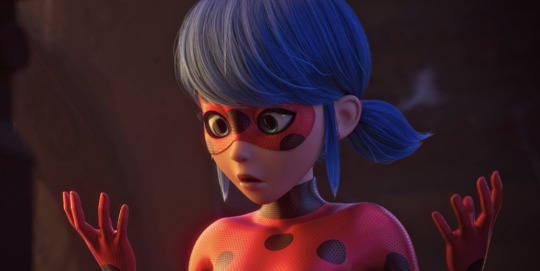
Did I mention Ladybug doesn’t use her lucky charm? Not. once. No crazy plans to show that she’s smart and creative. Just a pretty girl swinging around.
6. Adrien
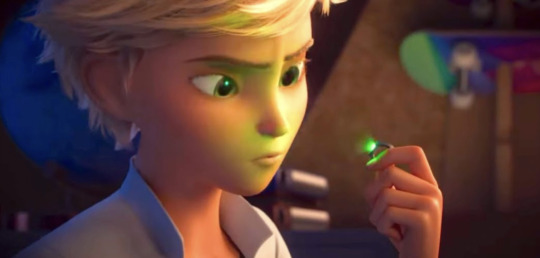
I have a bit more to criticize about the characterization of Movie!Adrien.
The longer I think about it, the more it becomes apparent that they really didn’t know how to write Adrien. His personality appears inconsistent, almost like they were trying to fit him in too many roles at once. He is either extremely closed off and mysterious (even towards his friends), a comic relief character, bathing in self pity or just outright cocky. Those hoping to see his politeness and selflessness will be disappointed. This character only is ever shown to be self centered. A perfect example is how he *didn’t do anything* to be called worthy of the Black Cat Miraculous. He was just one of the „chosen ones“. When the Adrien from the series sacrificed his own freedom to help Master Fu.
Another example is how this Adrien doesn’t really see anything in Marinette. He called her strange in their first interaction and never really lost a single thought on her throughout the rest of the series. No common praises, no support, just awkwardness and not the wholesome kind. In fact, I would argue Marinette and Adrien aren’t even friends in the movie, the only interaction to suggest otherwise was slammed as a 5 second scene in a 2 minute montage.
Even if you were to suggest their bond was formed off screen. We don’t really see it ever take root. He even turned down her gift and invitation to go to the ball with her. Yes, you guessed correctly. It was because he was busy bathing in self pity over being rejected by Ladybug. Yikes.
To sum it up, this Adrien really doesn’t care about anyone but himself. Ever. They massacred my boy.
7. Chat Noir
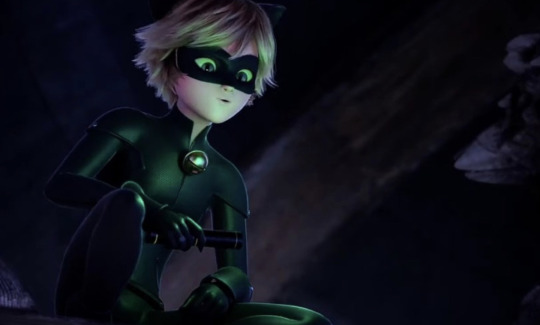
His charming smugness as Chat Noir crossed the fine line that turned to arrogance.
Considering how Adrien was characterized, that comes as no surprise.
As mentioned in my criticism towards the dialogue and the Ladynoir dynamic, this Cat is often seen discrediting LB with unfunny jokes. The moment you see him actually appreciate Ladybug, open up to her and Woo her, it’s all overshadowed by his entitlement to her affection.
Some may argue that we see traces of such attitude in the show as well. However, in a series, Chat Noir has many redeeming qualities as well as time to grow, change and move past these flaws. And boy, move past these flaws he did. In the movie, it’s all you get. Take it or leave it.
In one scene, he even lets her think he was hurt by an Akuma in order to catch her worrying about him. It was just a short scene and most people would look past it, but I think it’s these small details that really show how these movie characters tick in comparison to the series.
8. Akumas/Hawkmoth
Just a small detail that kind of ended up taking away the enjoyment of all action scenes is how the Akumas in the movie do not have a motive. There’s just some random people that you don’t care about before their akumatization and that you won’t care about after.
Hawkmoth doesn’t make a deal with them, ask for ladybug and chat noirs miraculous in exchange for his powers, none of that.
He just makes them evil and they do evil things for shits and giggles. The movies premise doesn’t even suggest he needs the miraculous. He just needs to get close enough to Ladybug and Chat Noir to steal Tikki and Plagg.
9. The Ending
I just wanted to dip into that ending real quick. In the movie, Gabriel is redeemed when he finds out about Chat Noir being Adrien. He apologizes to him and they make up. The scene surely will make people emotional, but from my perspective it was all rather predictable.
Whether or not Gabe was worthy of a redemption in the movie is a topic to discuss on its own. Personally, I was okay with it.
What I found more interesting however was…
10. The reveal
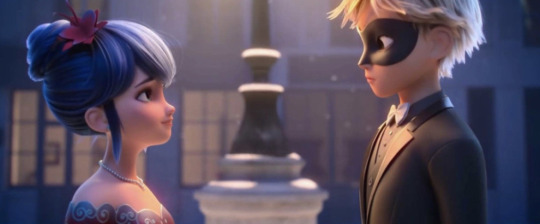
This is the moment most people have been waiting and yearning for. And I may sound a bit smug when I say that the movie served a good purpose to show us that a fast reveal would have never ever been satisfying!
It was super underwhelming because - of course it was!
Marinette and Adrien barely had a connection! For all we know they could have been total strangers and their reaction to each other’s identity wouldn’t have been any different than what we saw in the movie.
We never saw Marichat or Ladrien interact either. So that certainly lead to a less explored dynamics. Cue unsatisfying reveal.
They really tried to make it this big emotional final moment, but really? We just saw Ladybug and Chat Noir lean in for a kiss without their masks. Like in a new fit. Nothing really groundbreaking came out of it.
Any fake reveal in the show was better than that and I mean it with every fiber of my being.
And don’t even get me started on how Adrien only ever noticed Marinette when she revealed to be Ladybug. It’s just not it.
Final thoughts.
There’s sooo many more things that I could elaborate on but I think for now I’ve said enough to support my rather poor rating of the movie.
In my opinion, the movie relies too much on people enjoying the source material while trying to be its own thing. It risks leaving everyone unsatisfied.
Those who watch the movie as a stand-alone are met with weird dialogue as well as plot, characters and dynamics that aren’t at all fleshed out.
Meanwhile those who watch the movie because they like the show will be inevitably comparing the movie to its far superior source material.
#miraculous ladybug#ml#miraculous#ladybug#adrien agreste#chat noir#cat noir#marinette dupain cheng#miraculous the movie#awakening#mlb awakening#mlb movie#ladybug and cat noir the movie
613 notes
·
View notes
Note
hi, so in the comments of a recent post, you mentioned the fact that Georgia helped produce a lesbophobic movie, which movie was it and what happened?
Hi there! Yes, I did mention this in a comment on a post. The movie in question is called You, Me, and Him and it came out in 2017. It was written and directed by Daisy Aitkens, who is one of Georgia's best friends, and produced by Georgia, as well as by Phin Glynn (who also produced Staged, interestingly enough) and stars David as John Helm.
The basic plot (and warning for spoilers ahead) is that there is a lesbian couple, Olivia (who is in her 40s) and Alex (who is in her 20s), who are having problems/disagreeing about having children. Unbeknownst to Alex, Olivia begins undergoing fertility treatments but struggles to conceive. John (David's character) is their neighbor, and he is meant to be a sleazy, womanizing, "toxic alpha" type of guy. Alex goes to one of John's parties and gets extremely drunk, and they end up having a one-night stand, and as a result, Alex becomes pregnant.
So right out of the gate, the issue of dubcon (dubious consent) is apparent, as Alex was too drunk to consent, and arguably so was John, who was also intoxicated. The second problem is that them hooking up is characterized as Alex "cheating" on Olivia--despite her inability to give consent--and consequently, she and Olivia break up. Not long after, Olivia discovers that the fertility treatment worked, so she and Alex are pregnant at the same time. This then leads to John being the one who has to "fix" the situation between Alex and Olivia and try to get them back together.
Beyond that, there were several jokes about John "turning her straight" and the trope of Alex not wanting kids until a man came along and got her pregnant, which also felt like it made the wlw relationship become secondary to the growing relationship (though not romantic) between Alex and John. There also seemed to be the sexist trope of two women being too "emotional" to resolve their own problem and needing a man to do it for them. All of this is what gave me the impression of the movie being lesbophobic--not to mention just not being written well in general, which contributed to most of the issues I have outlined.
I do want to be clear that David is in no way blameless for his decision to take on the role of John and participate in the film. He wasn't originally cast in the part--which becomes painfully obvious because of how difficult it is to buy him as a toxic alpha male--but rather stepped in at the last minute as a favor to Georgia when the original actor dropped out, as he likely would not have played the role otherwise. And to his credit, he does somehow manage to imbue the character of John with a certain degree of charm, but even he couldn't save the movie from itself or the critics who reviewed it.
This is all my own opinion on the movie, of course, and I would urge you or anyone else who hasn't seen it to watch it and decide for yourself. I hope this helps to answer your question, though, and hopefully other folks will comment with their thoughts on the movie. Thanks for writing in! x
#itstoriyao#reply post#david tennant#soft scottish hipster gigolo#georgia tennant#you me and him#daisy aitkens#also thetardisisblueandroseistoo just posited that David was playing the role of John as a repressed gay man#which i had never considered before but now find extremely intriguing#but i will leave it to my followers to make up their own minds#LGBTQ+#thoughts#discourse
42 notes
·
View notes
Text
parallels between the boy and the heron and this painting, plus general analysis

Arnold Bocklin, Island of the Dead. 1880
i want to preface this by saying i am by no means an art history nerd, i just happen to know some stuff about the background of this painting in particular.
as soon as mahito is sucked into the tower floor he is standing at the shore of an island surrounded by an endless ocean. he is dwarfed by a large set of golden gates that say something like "those who seek my knowledge shall perish" and an even taller forest of cypress trees. these features all frame a white dolmen (primitive tomb usually made of giant rocks stacked like below) that beckons to him.
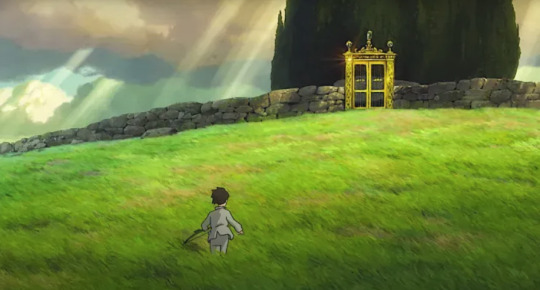
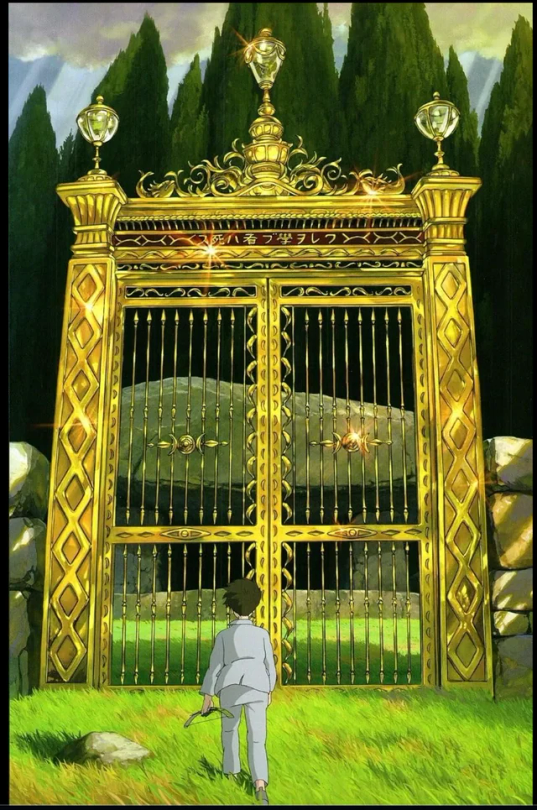
this scene immediately struck me since it has so many of the visual elements of the painting. mahito is even framed in the foreground to be so very small approaching these giant, daunting structures just like the boat heading for the island in the painting. besides the tombs, the cypress trees are also traditionally associated with mourning and death at least in europe/the mediterranean. other ghibli movies have lavish european aesthetics tied to characters (howl, yubaba, etc.) but it feels particularly intimate here given that mahito's great granduncle, the creator and ruler of this world, is apparently european and can only pass on his role to a direct descendant. (btw not saying the gaudy european decor signature of howl and yubaba aren't important to their characterization, it def is! i'm just saying it stood out to me in this movie especially.) the cliffs full of stone entrance passageways are prominent later in the movie as himi takes mahito through the parakeet's domain, and interestingly, in the delivery room where natsuko is, there is another dolmen behind her (can't find pics since the movie hasn't been uploaded yet urgh).
the backstory to the painting continues to parallel to the events of the story! so there's 5 versions of this painting. the first three versions were painted in a cemetery close to bocklin's residence which was also full of white headstones and sculptures, and cypress trees. one of his infant children, one of many children he lost, was buried there. the one i posted above is the first/second-- while bocklin was working on the first, a the soon-to-be wife of a politician visited his studio, saw the wip, and commissioned her own version with the added white figure and coffin to commemorate her first husband who had just died of diphtheria. already somewhat similar to how mahito's mother died in the hospital fire (well. she died from the fire but presumably she was there because she was sick) and when his father shortly remarried. these were also added to the initial wip and stuck in later versions of the painting. bocklin later wrote to her, "you will be able to dream yourself into the world of dark shadows". the movie is also very dreamlike-- it's a fantasy world filled with strange creatures, alternate versions of people he knows, and passages that seem to alter the fabric of time and space. people also seem to forget about it as soon as they leave even after spending long periods of time in it like a dream. the painting is also very dreamlike, but why? the warm lighting, maybe not in the version i posted but in a couple others, may explain it, but the island itself resembles the curtains and stage of a theater (referencing the audio clip below the description). even if it doesn't look EXACTLY like that to you, it's definitely a too-perfect little scene in a nebulous expanse of space. this theatrical quality is also shown in the movie by the parakeet uprising side plot as well as the scene when himi and mahito collapse in front of the delivery room-- the curtain falls directly in front of the viewer over them as though a stageplay just ended. oh and a friend mentioned to me how this is a classic hero's journey plot and mirrors orpheus in the underworld. island of the dead has also directly inspired NUMEROUS other works of art, including other paintings, stage productions, and symphonic poems. apparently the painting was so popular many people in berlin hung prints of it in their homes (i do too)! as i stated above though, a lot of the visual elements in the painting were already traditional symbols relating to death so i don't want to 100% conclude that miyazaki was directly inspired by this painting, he may have just also resonated with those symbols independent of bocklin which i still think is awesome.
the first time we see himi also reminded me of the painting. she's wearing a white dress and standing at the bow of a small wooden boat, and though her intentions are to save the warawara from the pelicans, she inevitably kills some of them too. visually and thematically she's like the white figure at the front of the rowboat in the painting. she acts as a guide for mahito (analogous to the rower? he traveled to this world of his own volition but needed a guide) for a good part of the movie and is a collage of life and death. she is a younger but kind of omniscient version of his dead mother; she's known all along she is mahito's mother but is about to be born into the world by the end of the movie and accepts her fate happily. she can control fire which envelops her like how she died in the real world, but is harmless to the touch unless she directs it as a weapon, and as we see with the warawara and pelicans it helps creation but also destroys much like fire's role in the natural world. natsuko, though a separate person from himi, is still connected as a sibling, and we see her wandering into the forest at the beginning of the movie while wearing white like himi, back turned to mahito, and that is what prompts him to first enter the tower. the strange nature of her character that doesn't adhere to a proper time or space parallels the way the white figure completely stands out in the painting, at least the ones with darker lighting. another crazy parallel surrounding fire and wwii between the painting and the movie is that the fourth version of this painting was destroyed during wwii due to bombing, again like how mahito's mother's hospital was presumably set on fire by bombing during the war.
the looming effects of war alluded to throughout the movie eventually tie into its resolution, when mahito accepts his new family that he initially rejected, his own imperfect being, and the fact that one must seek out love to be happy in this bitch of a world. his great granduncle is confused as to why mahito wouldn't want to recreate his own world like him. why would you want to return to the world that killed your mother and rejects you as a person? the world that forces your people to die in war and will eventually drop the deadliest weapon mankind has ever seen even a century from now onto your home? you can make everything perfect here! he's created something of a "paradise" himself, full of lush tropical plants, parakeets, and strange insects (some of them looked like the bugs from nausicaa, another fantastical world of lush nature which is also threatened by war. interesting), almost like a garden of eden, and it so happens to be at the very top of the tower. funnily enough, bocklin also painted this several years later:
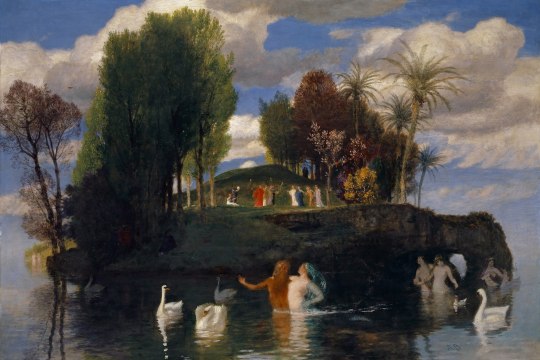
Arnold Bocklin, Island of Life. 1888
i don't know much about this one so idk if it's an explicit companion piece to the island of the dead but it certainly looks like it. the similarities are now less apparent to the movie if there are any, it's much less lush but there are exotic plants and uh birds and stuff. this is definitely more likely a case of shared inspiration from the symbols themselves rather than movie directly looking at the painting. anyway clearly the promise of a perfect paradise isn't real, as this is interrupted by a war of his own unwitting creation, the uprising of the parakeets he wanted to breed in a paradise that literally bring about the end of the world. no world will ever be perfect when left long enough to its own devices. life finds a way! plus, this world was created through so much death (the construction workers in hazardous conditions, the way the tower keeps spiriting people away. btw in the english sub mahito's dad calls the whole ordeal a "disappearance" but he says "kamikakushi" in japanese which means "hidden by god" in reference to people who mysteriously disappeared as if from supernatural circumstances and yes that's the word they used in the japanese title of spirited away!!!) and is on the verge of collapsing from reality every three days just because of some building blocks?? the real world may be on fire but it'll go out/burn less badly someday, and at least it won't completely disappear in a snap, not in an easily imagined timescale for a human anyway. it's up to you to make the best of it, and this is what mahito decides. there are also visual allusions to other ghibli movies about the constantly present threat or consequences of war. the only other landmark aside from the island mahito lands on is a line of ships which kiriko later tells him are all fake. it immediately reminded me of the stream of planes in porco rosso which were the souls of dead fighter pilots moving on. the shadow people in the swamp were also reminiscent of those in the train in spirited away, which are never explained to my knowledge but the given that spirited away's characters are largely spirits and the way souls are so similarly designed in this movie makes me feel that they were also souls of people in spirited away.
through this imagined otherworld, there is also the blurring of lines between life and death, reality and imagination. himi plus her dyad with natsuko (they're sisters AND they look exactly the same AND both are mother figures to mahito) are great examples of this. mahito's mother is gone, he knew this and set foot into the world anyway. he rejected natsuko as his new mother but in going through the struggles of the tower he comes to accept familial love for her and even keeps confusing "natsuko" and "mom" while reaching out to her in the delivery room. a family is made up of different people but inevitably you will see each other in each person. in the delivery room scene we see the paper hanging from the ceiling lash out to attack and stick to mahito like tape, it even leaves red marks on him. this is one of the best scenes in the movie to me because of its visual contrast to him rushing to save his mother in the fire. in the fire scene, the real world around him is blurred and distorted and at times so is mahito and especially his mother. the fire doesn't seem to burn him or his clothes (i could be remembering that wrong tho) and the scene cuts off before it shows him possibly going in further. in the delivery room, everything is drawn with clean lineart, no stylization. there is no mistaking the reality of this situation even though this world is conjured, the dawning realization upon mahito that this person is his mother is so visceral that he actively fights through the paper literally snapping its jaws and natsuko spitting her hatred towards him. when mahito is ready to leave the tower, himi leaves through a separate door to be born as his mother sometime in the past though she is not a warawara and knows what has happened/will happen, an exception that further demonstrates the nonlinear nature of time and space in the movie.
after coming out of the tower, the heron tells mahito he should forget everything that happened in there. even his grandmother seemed to have forgotten the whole year she spent in there (it seems like tower time reflects irl time judging by the events of the movie). anything that comes out doesn't just disappear, it transforms into a real-life counterpart as we saw with the pelicans leaving as they were (presumably minus the ability to speak) and the parakeets going from big bloodthirsty things to regular parakeets. so mahito can't just forget, especially because he comes out changed from his experiences in there, not just himself personally but also his changed relationships with natsuko and the heron, and also his little souvenirs. then the movie abruptly ends with mahito narrating that they left for tokyo again shortly after the war ended. i like to think that this was a hopeful ending where mahito maintained that character development and was able to welcome natsuko and his new sibling into his family while being able to seek more friends and family in the future. i've seen other analyses talking about how this movie was semi-autobiographical for miyazaki and i can see it, how events early in his life shaped his personality and how he had to fight to find beauty in a world that otherwise treated him poorly, so i'm glad he ended the movie on that note, although in less words. pretty similar to how spirited away ended, although there was arguably more loss involved, but still hopeful, and that's what i find so powerful about this movie. and like this movie, spirited away involves a dyad between yubaba and zeniba as a device for the hardships and beauty of life, how they're not so discreet at times. as a last kindasorta tie-in to bocklin's work, i'll point again to the island of life which was created after the island of the dead, plus a composition directly inspired by the island of the dead, a symphonic poem with the same title written by sergei rachmaninoff. the last time i listened to this was in high school and it's like. 20 minutes long so i'm too impatient to give it a relisten now but from my vague recollection plus some quick searches it's a very somber piece that escalates into emotional climaxes yet still contains warmer tones, and goes back to the same "rowing" motif at the end. it weaves together evocations of life and death in one piece, also illustrating how the two really are so closely connected.
tl;dr, this was me the entire movie because miyazaki SEEMS to be heavily inspired by this one symbolist painting i happen to like a lot:
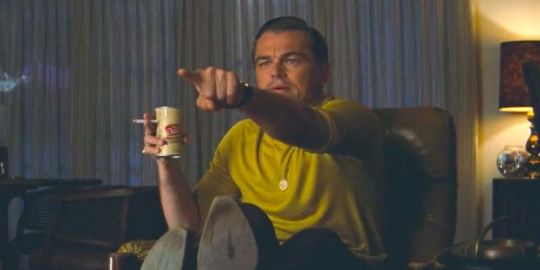
also also here's a self portrait of bocklin:
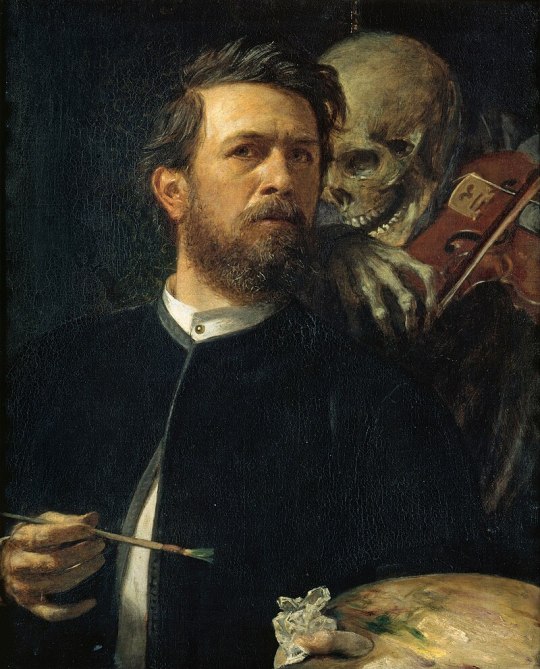
yes, all of his paintings are that cool.
#i'm so excited about this painting!!#there's so many freaking similarities in not just the painting itself but its conception#the boy and the heron#kimitachi wa do ikiru ka#how do you live#studio ghibli#hiyao miyazaki#arnold bocklin#island of the dead#isle of the dead#tweet
72 notes
·
View notes
Video
youtube
“Nosferatu” Symbolism & Ending Explained - Book & Hearth
This is a fantastic video analysis by an IRL psychologist, occultist, and Romanian, so watch the whole thing! I wanted to highlight a few bits she discussed that I liked most, following my review of Nosferatu, and how much I liked the handling of mental illness and its depiction in a Gothic/Victorian setting.

Sex & Death
One thing that I love about the vampire legend is how the meaning shifts with the times and the specific individual who created that piece of artwork. In Bram Stoker's original Dracula, The Vampire represented the fear of sexual promiscuity in a time of increasing bloodborne STDs, as well as the fear of predatory Eastern foreigners coming to ravage good Christian women. In Francis Ford Coppola's remake of Bram Stoker's Dracula, the vampire's meaning shifted a bit, to represent sexual temptation within a monogamous relationship. ...But in Robert Egger's Nosferatu, the vampire represents Death itself. Nosferatu's pull on Ellen reveals Ellen's pull towards death, as she becomes deeper and deeper entrenched into her Melancholia. (8:06 - 8:52)
Melancholia, Depression & Hysteria
Now, “melancholia” is just an old-timey word for Depression. it's the predecessor of depression from the Victorian era. In the beginning of the movie, it's hinted that Ellen has a history of melancholia, and Thomas dismisses her dreams of dread and urges her not to speak of these things out loud--which is pretty consistent with the reaction to Ellen's worsening mental health issues.
As the movie deepens, the reaction is to further constrict her emotions with corsets and bondage and to dope her up. It really shows how mental health issues were treated for women in the Victorian era: Keep it bottled up, or else Society is going to tire of you, and they might give you a lobotomy, they might drug you with opiates, they might bleed you, they might call you hysterical, they might lock you up in an insane asylum, they might give you a Hysterical Paroxysm (which was a doctor administered orgasm)--

--because you see, crazy women were seen as “hysterical,” from the Greek word hyster which meant womb--

--because “hysteria” was seen as being caused by a “wandering womb;” your womb wandering around in your belly. Hysteria is the predecessor of modern-day Histrionic Personality Disorder, which is a disorder characterized by excessive attention-seeking and interestingly: pseudo-seizures, which are seizures that are not caused by epileptic brain waves.... So it completely tracks that Ellen has both hysteria and seizures. (8:52 - 10:09)
...Later in the movie Ellen flatout says: “He [Orlock] is my Melancholy, and now he's discovered our marriage and come back.” Once, she was happy as a newlywed, but when her depression found out she was happy, he got jealous and he came back to end her happiness. We see how Thomas has to compete with Ellen's melancholia, her depression tells her that he's not good enough for her, that he gave up their nuptials for gold--which has a seed of truth, but also shows how depression can distort things and convince us that the people who love us don't actually love us. (10:22 - 10:48)
...Life sometimes pushes people into the arms of depression. In the final scene, Ellen dresses up as a bride and she willingly prepares to meet Death... Depression is almost like a marriage to Death; and I wondered if the consummation of their marriage was a metaphor for suicide--giving into the melancholia, sacrificing herself to save the others from her depression. (11:00 - 11:22)
Shadow Self, and the Evil Within Us
Nosferatu is Ellen's [Jungian] Shadow.... We see when he's coming for her the shadow of Nosferatu's hand extending across the city, and Ellen asks the crucial question: "Does evil come from within us, or from beyond?” ...At another point in the movie somebody says: “We must discover evil within ourselves to defeat it;” which is essentially what Shadow Work is: uncovering these parts of ourselves that we've buried and deciding to look at them in the face. (13:12 - 14:09)
....Nosferatu also takes place during Christmas, which is the darkest time of the year, but also the time of year when when Christ is born. And Nosferatu is the shadow of the Christ--the Antichrist. So, Nosferatu represents two things at once: both the demon within and also the demon externalized. (14:53 - 15:11)
#nosferatu 2024#gender inequality#gothic horror#ancient greece#read a dang history book#must see tv#the hype is real#videos#youtube#nosferatu#vampires
6 notes
·
View notes
Note
So I was on Quora the other day, and someone speculated that insecurity was at the root of Anakin's arrogance and apparent cockiness. I thought this through and it makes so much sense. He felt insecure in his place as a Jedi and had this constant need to prove himself. What's your take?
Personally, I’ve never seen Anakin as arrogant. I think he was *perceived* as arrogant by the people around him but, internally, Anakin was also driven by insecurity (not egotism).
Because he was so insecure in a place where he knew he wasn’t accepted as he was, he overcompensated. It’s a very common behavior: I’ll try harder to prove myself. And because he was so powerful, his attempt to prove himself worthy was viewed as an attempt to show off.
The Jedi Council didn’t want me, either. Being the Chosen One didn’t count for anything. Master Yoda wouldn’t train me, or Windu. Every member of the Jedi Council had had something more pressing to do than help him work out what this terrible, galaxy-changing power of his meant, and how he should live in its shadow. He still wasn’t sure. Anakin recalled standing there in that grand, polished Jedi Council Chamber, surrounded by what felt like fear, and disdain, and bewilderment—who were those Masters to feel bewildered, that the only person there who cared if he lived or died was Master Qui-Gon Jinn. And they stopped him training the Chosen One. Qui-Gon hadn’t cared what the Jedi Council said. He’d trained him anyway, a Padawan in all but name. Why am I thinking of all this now? Haven’t I put it behind me? Haven’t I had enough bad memories since then to take their place? Haven’t I vindicated Master Qui-Gon? [Karen Traviss. The Clone Wars]
Anakin enjoyed praise from Obi-Wan, but often became sullen when he was reprimanded. Obi-Wan assured him that he himself had been frequently reminded by Qui-Gon to be more mindful of the Force, but somehow even the slightest criticism managed to leave Anakin feeling stung. First they tell me to do my best, then they tell me I’ve gone too far! ANAKIN SKYWALKER IN THE RISE AND FALL OF DARTH VADER BY RYDER WINDHAM
Because Anakin had not been trained since infancy at the Temple like nearly all other Padawans, various Jedi Masters accepted the fact that he lacked the discipline of his fellow students. They were less accepting, however, of his arrogant behavior when he demonstrated his abilities. I’m more powerful with the Force than some of my instructors, Anakin thought, and they know it! ANAKIN SKYWALKER IN THE RISE AND FALL OF DARTH VADER BY RYDER WINDHAM
Despite Anakin’s desire to distance himself from the slave he had once been, he was unable, or unwilling, to shed the other aspects that had defined him on Tatooine. He still dreamed of glory, still craved adventure, and never lost his appetite for high-speed thrills and the desire to prove himself in competition. THE RISE AND FALL OF DARTH VADER BY RYDER WINDHAM
What evidence to we truly have that Anakin was arrogance beyond people calling him that? And considering most of his peers and superiors didn’t take much time to get to truly know him, I’d say their option can be considered biased:
Anakin was liked by the other students, but he had no close friends. He was not loved. Obi-Wan told himself that Anakin’s gifts naturally set him apart. But in his heart, he grieved for Anakin’s loneliness. JUDE WATSON [JEDI QUEST: THE WAY OF THE APPRENTICE]
Just when Anakin thought he’d passed that elusive finishing line that said adult, experienced, seen it all, he realized he was still twenty, Jedi or not, and the wounded boy in him still rose to the surface—provoked into angry violence, scared of abandonment, and still in need of approval. KAREN TRAVISS [STAR WARS: THE CLONE WARS NOVELIZATION]
[Obi-Wan] knew, glancing at his Padawan’s eager face, that Anakin meant well from the bottom of his heart. If Obi-Wan saw a shadow on that heart, he knew it would pain his Padawan to know it. In many ways, Anakin was still a boy. A wounded, loving, anxious boy with great gifts he did not fully understand. Yet he was also a young man, close to maturity, who could do great harm. To others, yes. To himself, most of all JUDE WATSON [JEDI QUEST: THE SCHOOL OF FEAR]
“I just…” Anakin stopped. He took a ragged breath. “I thought you would be proud of me.” I am proud of you. Obi-Wan wanted to say the words. They were true. He was proud of so much in Anakin. But now was not the time to tell him that. Or was it? JUDE WATSON [JEDI QUEST: THE SCHOOL OF FEAR]
Fixing broken machines was like a meditation. Fixing broken machines was an antidote to every pain, every loss, every fear, every defeat. Fixing broken machines kept him from going mad. CLONE WARS GAMBIT: STEALTH
This doesn’t sound like some who thinks that highly of himself.
“Master…,” he said hesitantly, “I know I’ve… disappointed you in these past few days. I have been arrogant. I have… not been very appreciative of your training, and what’s worse, of your friendship. I offer no excuse, Master. My frustration with the Council… I know that none of it is your fault, and I apologize. For all of it. Your friendship means everything to me.”
Interestingly enough, Obi-wan says it best:
You are very observant, Ferus, but you must accept that I know him better than you,” Obi-Wan said carefully. “Anakin can be arrogant. I know that. But he is also learning and growing. He is respectful of his great power. He does not abuse it. He is younger than you, but he has seen much injustice, many terrible things. I do not think it so wrong that he wants to change things. You must understand that it isn’t ambition that drives him. It is compassion. OBI-WAN KENOBI IN STAR WARS – JEDI QUEST: THE CHANGING OF THE GUARD BY JUDE WATSON
Yes. Anakin can act arrogantly. We all can. It’s part of being human and flawed. but that doesn’t mean that was ALL Anakin was. More often than not, Anakin was motivated by fear, love, kindess and, yes, even hate.
Taking them, she looked up at him and shook her head, even though it still ached. “It’s odd. You’re nothing like I expected.” “Why?” he said, perching on the edge of the nearby chair. “What did you expect?” “I don’t know,” she said, floundering. “I can’t say I’ve ever given the Jedi much thought. I mean, not as individuals. I never expected to meet one—let alone two. I don’t tend to go places where your skills are needed. But—well—you’re gentle.” That made him smile. “As opposed to what?” She swallowed the pain-tabs, washing them down with a mouthful of water. “Oh. You know. The HoloNet news—it portrays as you as this—this—heroic warrior. Larger than life. Charging into battle, lightsaber flashing. Scourge of the Separatists. That kind of thing.” She shrugged. [Karen Miller. Star Wars: Clone Wars Gambit: Stealth]
Because of Hayden’s Anakin being do disliked and, of course, because of the TCW wonky characterization everyday we are seeing more and more people embracing the idea of arrogant idiot Anakin. even if such characterization is not supported by the movies, the lore and basic common sense.
People use Obi-wan’s words in AOTC against Anakin but the truth is, as shown above, Obi-wan himself later recognizes that Anakin is not arrogant (even if he sometimes act that away). Besides, using AOTC to show Anakin’s arrogance doesn’t make much sense because of Hayden’s acting. Anakin doesn’t act like some arrogant prick for most of the movie. if anything, AOTC is a great of example of Anakin’s submissive and insecure behavior.
At last, let’s not forget that the same people calling Anakin arrogant were also facing the same criticism:
“But he still has much to learn, Master,” Obi-Wan explained. “His skills have made him … well, arrogant.” “Yes, yes,” Yoda agreed. “It’s a flaw more and more common among Jedi. Too sure of themselves, they are. Even the older, more experienced Jedi.” [R.A. Salvatore. Attack of the Clones]
People seem to forget that Anakin was in his early 20s when he ‘died’. Show me a teenager or a young adult who’ve never acted arrogantly and i’ll show you a liar. So why is Anakin the only one getting shit for that?
So, yeah, i agree. Anakin wasn’t motivated by arrogance. He was motivated by fear and insecurity, byproducts of his childhood trauma and years of grooming and emotional neglect.
334 notes
·
View notes
Text
Hurricane Touchdown and the “one summer’s adventure”

I’ve covered Hurricane Touchdown a few times already, but in honor of @golden-digimental-up I felt like I wanted to do something new for it, so today I decided to talk about the cultural context surrounding this movie’s atmosphere and themes. Specifically, Hurricane Touchdown leans heavily on a certain “one summer’s adventure” (hito natsu no bouken) concept that, interestingly enough, was heavily popularized by Western media, most notably the movie Stand by Me.
Usually, when you talk about this concept in relation to Digimon, it has more to do with the original Adventure, because that’s a summer coming-of-age narrative and naturally Digimon’s most standout example of it; Kakudou cited it directly as one of Adventure’s many influences, which is unsurprising since he’s quite a fan of Western cinema, and it’s very likely that the reveal of Takeru being the story’s writer at the end is a huge reference to it. However, Stand by Me is heavily influential in Japan in general, and while this association is a bit weaker with 02 since it spans most of a whole year in the real world, we have this movie, which had no involvement from Kakudou at all, but is arguably even more blatant of a reference to this concept. (I mean, when your ending song is literally named Stand By Me ~One Summer’s Adventure~, subtlety has just gone out the window.)

I don’t think the genre I’m referring to has a solidified name in either Japanese (besides the phrase “one summer’s adventure” constantly cropping up) or English, but I think, if I describe it, you’ll probably recognize the kind of story I’m talking about: a secret adventure between kids, often having to be hidden from their parents, possibly involving a treasure map or some kind of hidden discovery or hideout, and usually during some fleeting time period like summer when everything has to be done before school starts again. There’s a strong association with it being a coming-of-age story for children, and, combined with the fleeting time period it takes place in, has a theme of cherishing your ability to have a free-range childhood adventure like this, free from the expectations of adults, while you still can. In Japan, the most popular standout example of this is Stand by Me, but other works with this concept include things like Bridge to Terabithia, The Goonies, Stranger Things, Gravity Falls (which amusingly involves a finale that’s suspected to be referencing Adventure’s), and Luca. On the Japanese end, works like Looking for Haru, Atelier Ryza, Goodbye, Don Glees!, and Drifting Home take obvious cues from the genre.
Given that, perhaps due to the Western taste of the movie taking place largely in America -- and not just America, but a journey to a rural village in Colorado -- and the premise of “a secret shared adventure that we engage in during the summer and hide from the adults”, there are certain ways in which Hurricane Touchdown arguably more greatly resembles those works than the original Adventure. The hitchhiking, the running around the countryside, Wallace sneaking around on his “journey to become an adult” and making shaky excuses to his mom. Even the memories that Wallace invokes of his childhood with Chocomon and Gumimon have a strong sense of a young boy sneaking out with his friends to go have secret adventures under his mom’s nose. And when you contextualize Hurricane Touchdown’s place in 02′s story, it’s a summertime side story that’s set smack in the middle of its narrative, a one-time encounter with a boy in America, a memorable incident and “adventure” they were able to have together with him without having to worry about school or the other daily real-life pressures that characterized most of 02′s real-world, yearlong narrative. It’s the one precious encounter they were able to have in their childhoods, detached from their other pressures -- and, in this case, detached from even their other ongoing issues with fighting the Kaiser. Despite how much 02 took place in the real world, the kids didn’t spend that much time doing rulebreaking or anything particularly under-the-table during the actual series itself, but this movie has Wallace sneaking onto trains and the kids constantly hitchhiking.
To some degree, you could even argue that there’s a sort of criticism of urbanization in here, because there is a strong association with these narratives and backwater, sleepy towns because of the higher range of freedom afforded, and all six kids in Hurricane Touchdown’s narrative are coming from heavily urbanized areas -- the Japanese kids from Tokyo, and Wallace from New York, clinging to his older childhood memories from having lived in the rural town of Summer Memory. One might even wonder if Wallace is so dead-set on wandering around in the countryside because the restrictive urban life of New York just doesn't agree with his free-spirited personality.

In fact, a lot of this movie looks like it came straight out of a movie a few decades older than it really should be, and part of it might be because of the fact they didn’t do actual location scouting and thus weren’t referencing real locations, but when you consider the theme of this movie heavily centering around nostalgia, and the rustic, acoustic-themed soundtrack, the movie’s backdrops seeming a bit outdated is kind of the point; a lot of this is about having nostalgia for a bygone era and being overly attached to it.

Interestingly, Wallace wants this to be his coming-of-age narrative; he outright claims that he’s on “a journey to become an adult” while on the phone with his mother, justifying it as to why he’s wandering around in Colorado, but Daisuke implicitly calls him out for being all talk for pointing out that for all Wallace is claiming to be an adult who does whatever he wants, he’s still dropping everything to call his mother (after all, weren’t these narratives about doing independent things detached from what adults expect of you?). And, when you really think about it, as much as Wallace wants to believe he’s on his own Stand by Me journey, in actuality, he’s basically running away and in denial. Instead of accepting that things have changed since his childhood and that Chocomon has already become something completely different, he convinces himself that ditching home and hauling himself all the way back to Summer Memory will somehow make everything better.
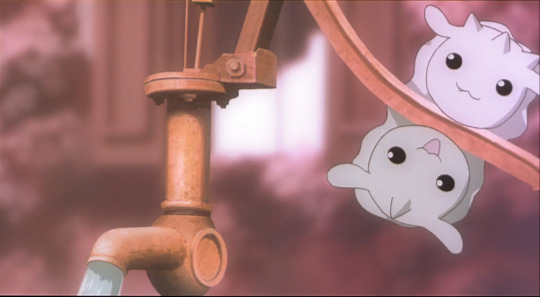
Note the name of the village, too -- the village of Summer Memory is fictional, but Wallace’s fixation on returning back to it represents his inability to move on from, indeed, his memories of summer back in the countryside. Even the moment he steps back into it, he ends up constantly getting distracted and lost in thought about those memories playing with Chocomon and Gumimon, with a sentiment that almost feels fully drenched in “when times were simpler”. Later, Wallace confesses to Daisuke that he was never able to stop thinking about Chocomon, not even after moving to New York; his entire life since his loss of Chocomon has involved hangups and thinking about things he can’t get back, and it’s also another presumable factor as to why his personality is so “warped”. Wallace’s supposed “journey to become an adult” is actually just him clinging even more childishly to the things he can’t let go of. In the end, he’s not that different from Chocomon himself, who will accept nothing less than Wallace at the exact age they parted at.

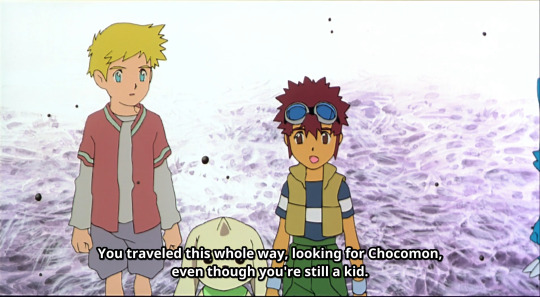
But if you've seen Stand by Me, while the journey may have started just as a way to check out a dead body, what really led to the growth in the coming-of-age story was the fact that the boys ended up bonding and spilling their emotional problems out to each other, becoming such good friends that even after their adult lives went in different directions, their relationship became unforgettable. After having spurned the others’ help for a fashion, it’s eventually through Daisuke going out of his way to reach out to Wallace that he’s finally able to accept what he needs to move forward and on with his life. All of this is an acknowledgment of the real meaning behind of this: Wallace admits that he’s been acting like a spoiled child, and because of that, after having accused Wallace of having been clingy with his parents earlier, Daisuke acknowledges that Wallace’s journey all the way down to Colorado actually did have meaning -- even though, in the end, he’s still “just a kid”.


And, as with many of these narratives, the story ends with the kids parting. Even putting their different nationalities aside, Wallace lives too different of a life from the other kids because he seems to enjoy the wandering lifestyle, and moreover, even if he does eventually get Chocomon back, there’s no denying that he’s still never going to be able to return to that life they had together. On the Japanese kids’ end, the summer adventure is now over, and they’ll have to return to Japan and get back to school and juggling the fight against the Kaiser and a hectic year that we know they’ll be having in canon. But nevertheless, Wallace states that they might meet up again (and they do, if The Door to Summer is any indication), and it’s clear at the end that this is an encounter Daisuke and the others won’t forget easily.
66 notes
·
View notes
Text
Why all the white guys in whump?
I got Inspired by a post asking that question, and here we are. Warning: long post ahead.
I think it’s due to a combination of factors, as things frequently are.
The preference for / prevalence of white male characters in fandom is well-known and has been examined pretty thoroughly by people already.
What’s worth noting for discussing this tendency in whump in particular is that the ‘whump fandom’ itself is not a ‘fandom’ in the traditional sense of being made of fans of one single source narrative (or source setting, like a particular comics fandom, or the Star Wars extended universe) with pre-existing characters. Although subsets of traditional fandoms certainly exist within the larger whump fandom, a lot of whump is based on original, ‘fan’-created characters.
So, given the tendency of ‘traditional’ fandoms to create stories disproportionately centered on white male characters due to the source material itself being centered on white male characters (and giving more narrative weight to them, characterizing them better, etc), if we say hypothetically that the whump fandom is split say 50/50 between ‘traditional’ fandom works and original whump works, you’d expect to see a higher number of works focused on white men than the demographics of the ‘traditional’ fandom’s source work would predict, but not as extreme of a divergence between the source material & the fanworks as the one you’d see if whump fandom were 100% based on popular media.
However, that doesn’t quite seem to be the case. Whump stories and art remain focused on overwhelmingly male and frequently white characters, which means that the tendency of the fandom to create stories disproportionately centered on white male characters cannot be ONLY explained by the source material itself being centered on white male characters (and giving more narrative weight to them, characterizing them better, etc).
And, having established the fact that whump writers & artists presumably have MORE control over the design of their characters than writers & artists in ‘traditional’ fandoms, we have to wonder why the proportions remain biased towards men, & white men in particular.
—
The race thing is pretty simple in my opinion. Mostly, it’s just another extension of the fanbase’s tendency to reflect the (predominantly US-American, on tumblr) culture it exists in, which means that, in a white-centric culture, people make artworks featuring white people.
There’s also the issue of artists being hesitant to write works that dwell heavily on violence towards people of color due to the (US-American) history of people of color being violently mistreated. I’ve actually seen a couple of posts arguing that white people SHOULDN’T write whump of nonwhite characters (particularly Black characters) because of the history of actual violence against Black bodies being used as entertainment, which means that fictional violence against Black people, written by white people, for a (presumed) white audience, still feels exploitative and demeaning.
I'm not going to get into all my thoughts on this discussion here but suffice to say that there's probably an impact on the demographics of whump works from authors of color who simply... don't want to see violence against people of color, even non-explicitly-racialized violence, and then another impact from white authors who choose not to write non-white characters either due to the reasons stated above, or simply due to their personal discomfort with how to go about writing non-white characters in a genre that is heavily focused on interpersonal violence.
Interestingly enough, there’s also a decent proportion of Japanese manga & anime being used as source material for whump, and manga-styled original works being created. The particular relationship between US-American and Japanese pop culture could take up a whole essay just by itself so I’ll just say, there’s a long history of US-Japanese cultural exchange which means that this tendency is also not all that surprising.
—
GENDER though. If someone had the time and the energy they could make a fucking CAREER out of examining gender in whump, gender dynamics in whump, and why there seems to be a fandom-wide preference for male whumpees that cannot be fully explained by the emphasis on male characters in the source text.
I have several different theories about factors which impact gender preference in whump, and anyone who has other theories (or disagrees with mine) is free to jump in and add on.
THEORY 1: AUTHOR GENDER AND PERSONAL EXPERIENCE.
Fandom in general is predominantly female, although these days it might be more accurate to say that fandom is predominantly composed of cis women and trans people of all genders. However, pretty much everyone who isn't a cis man has had to contend with the specter of gendered violence in their real personal life. Thus, if we posit whump (and fandom more generally) as a sort of escapist setup, it's not hard to see why whump authors & artists might willfully eschew writing female whumpees (especially in the case of inflicted whump), because (as in the discussion of people of color in whump above), even violence towards women that is explicitly non-gender-based may still hit too close to home for people whose lives have been saturated with the awareness of gender-based violence.
THEORY 2: SICK OF SEXY SUFFERING.
Something of an addendum to theory 1, it's worth noting that depictions of female suffering in popular media are extremely gendered (in that they specifically reflect real-life gender-based violence, and that said real-life violence is almost exclusively referenced in relation to female characters) and frequently sexualized as well. There's only so many times you can see female characters having their clothes Strategically Ripped while they're held captive, being sexually menaced (overtly or implicitly) to demonstrate How Evil the villain is, or just getting outright sexually assaulted for the Drama of it all before it gets exhausting, especially when the narratives typically either brush any consequences under the rug, or dwell on them in a way that feels more voyeuristic and gratuitous than realistic and meaningful. All this may result in authors who, given the chance to write their own depictions of suffering, may decide simply to remove the possibility of gendered violence by removing the female gender.
THEORY 3: AUTHOR ATTRACTION.
I'll admit that this one is more a matter of conjecture, as I haven't seen any good demographic breakdowns of attraction in general fandom or whump fandom. That said, my own experience talking to fellow whump fans does indicate that attraction to the characters (whether whumpers, or whumpees) is part of the draw of whump for some people. This one partially ties into theory 1 as well, in that people who are attracted to multiple genders may not derive the same enjoyment out of seeing a female character in a whumpy situation as they might seeing a male character in that situation, simply because of the experience of gendered violence in their lives.
THEORY 4: ACCEPTABLE TARGETS.
The female history of fandom means that there's been a lot more discussion of the impacts of depicting pain & suffering (especially female suffering) for personal amusement. Thus, in some ways, you could say that there is a mild taboo on putting female characters through suffering if you can't "justify" it as meaningful to the narrative, not just titillating, which whump fandom rarely tries or requires anyone to do. This fan-cultural 'rule' may impact whump writers' and artists' decisions in choosing the gender of their characters.
THEORY 5: AN ALTERNATIVE TO MAINSTREAM MASCULINITY.
Whump fandom may like whumping men because by and large, mainstream/pop culture doesn't let men be vulnerable, doesn't let them cry, doesn't let them have long-term health issues due to constantly getting beat up even when they really SHOULD, doesn't let them have mental health issues period. Female characters, as discussed in theory 2, get to ("get to") go through suffering and be affected by it (however poorly written those effects are), but typically, male characters' suffering is treated as a temporary problem, minimized, and sublimated into anger if at all possible. (For an example, see: every scene in a movie where something terrible happens and the male lead character screams instead of crying). So, as nature abhors a vacuum, whump fandom "over-produces" whump of men so as to fill in that gap in content.
THEORY 6: AMPLIFIED BIAS.
While it's true that whump fandom doesn't have a source text, it's also true that whump fans frequently find their way into the fandom via other 'traditional' fandoms, and continue participating in 'traditional' fandoms as part of their whump fandom activity. Bias begets bias; fandom as a whole has a massive problem with focusing on white male characters, and fans who are used to the bias towards certain types of characters in derivative works absolutely reproduce that bias in their own original whump works.
—
I honestly think that there is greater bias in the whump fandom than anyone would like to admit. Maybe I'm wrong, but it seems as though whump fans avoid introspection and discussion of the issue by bringing up the points I talked about in my previous theories, particularly discomfort with depictions of female suffering for amusement.
However, I think that, as artists, we owe it to ourselves and one another to engage in at least a small amount of self-interrogation over our preferences, and see what unconscious or unacknowledged biases we possess. It's a little absurd to argue that depictions of women as whumpees are universally too distressing to even discuss when a male character in the exact same position would be fine and even gratifying to the person making that argument; while obviously, people have a right to their own boundaries, those boundaries should not be used to shut down discussion of any topics, even sensitive ones.
Furthermore, engaging in personal reflection allows artists to make more deliberate (and meaningful) art. For people whose goal is simply to have fun, that may not seem all that appealing, but having greater understanding of one's own preferences can be very helpful towards deciding what works to create, what to focus on when creating, and what works to seek out.
—
GENDER ADDENDUM: NONBINARY CHARACTERS, NONBINARY AUTHORS.
Of course, this whole discussion so far has been exclusively based on a male-female binary, which is reductive. (I will note, though, that many binary people do effectively sort all nonbinary people they know of into 'female-aligned' and 'male-aligned' categories and then proceed to treat the nonbinary people and characters they have categorized a 'female-aligned' the same way as they treat people & characters who are actually female, and ditto for 'male-aligned'. That tendency is very frustrating for me, as a nonbinary person whose gender has NOTHING to do with any part of the binary, and reveals that even 'progressive' fandom culture has quite a ways to go in its understanding of gender.)
Anyways, nonbinary characters in whump are still VERY rare and typically written by nonbinary authors. (I have no clue whether nonbinary whump fans have, as a demographic group, different gender preferences than binary fans, but I'd be interested in seeing that data.)
As noted above with female characters, it's similarly difficult to have a discussion about representation and treatment of nonbinary characters in whump fandom, and frankly in fandom in general. Frequently, people regard attempts to open discussions on difficult topics as a call for conflict. This defensive stance once again reveals the distaste for requests of meaningful self-examination that is so frequent in fandom spaces, and online more generally.
—
TL;DR: Whump is not immune to the same gender & racial biases that are prevalent in fandom and (US-American) culture. If you enjoy whump: ask yourself why you dislike the things you dislike— the answer may surprise you. If you create whump: ask yourself whose stories you tell, and what stories you refuse to tell— then ask yourself why.
#eposting#whumpinions#whump#whumpblr#whump community#essay#i wrote this so yall all have to read it lol#but seriously the next person who implies that a nonbinary person is just 'woman-lite' or 'man-lite' is going to Die By My Fucking Sword#mine
232 notes
·
View notes
Text
ok ok. just some misc thoughts
when i watched the film i was surprised by how little screen time frank had, and i didn't know that was true in the book, too. margaret also gets little attention. they're hardly even antagonists, just sort of people who piss hawkeye off. the show needed antagonists, though, so they were made to fit that role. frank's treatment of private boone is honestly his only actual 'villainous' moment.
frank's a captain rather than a major. margaret outranks him. this is a book-only thing, interestingly. i think book margaret's meant to be quite a bit older than him, too; she's described as being in her forties, whereas we know book hawkeye is in his late twenties, so i think it's safe to guess frank's around that age too. both of these things mean there's a totallyyy different power dynamic - although it's not expanded on much. meanwhile on the show theyre peers, in both rank and age, but frank has seniority purely because he's a man, which i've always found interesting. but that's a discussion for another day. (also, book frank's a draftee!)
because we don't actually see much of frank in the book, his personality isn't expanded on much. i really didn't realize how much stuff was developed for the show. but we do know book frank is, essentially, a prideful rich spoiled brat. and, even more interestingly, he's a good surgeon. aka... he's basically a more callous charles. it's like they cherry picked qualities to put into frank, and the ones they didn't use got put into charles six seasons later. i hadn't realized that! frank's christianity is also inconsistent; book frank only mentions god when he's deflecting blame for patients he can't save, film frank's a bible-thumper, and show frank only sporadically cares. the only thing that's consistent across the board with his characterization is him whining to henry whenever hawkeye's mean to him.
hawkeye and frank seem to have switched two qualities from book to show; hawkeye's married in the book and frank's marital status is never mentioned (although in the film he has a ring on), and frank's dad in the book is a doctor.
this one's really interesting; it's semi vague whether or not frank and margaret actually have an affair in the book. it's implied, through innuendo, but not explicitly stated. the swamp rats assume they did; henry assumes they didn't. and the film's microphone sex scene isn't there at all. neither was the shower scene. apparently that was only at film margaret's expense. lol.
speaking of. in both the book and film, frank gets kicked out for punching hawkeye defending margaret's honor. honestly book and film frank & margaret are not antagonists
onto margaret, she's not even dwelled on much. the main takeaway i had is that the movie decided to sexualize and degrade her and go a 'buttoned up bitch during the day, voracious slut at night' route that's very quintessential 1970-era misogyny, the book refers to her as a 'femme fatale' but otherwise doesn't really imply much, and the show had to try to strike a balance that took it a few years to figure out. it's hard to even compare the three depictions because the show's margaret is the only one who's treated as a person. and to think she ended up being one of the best written female characters in television history.
and on the other hand, frank frank & frank. book frank is a scummier charles, film frank is just sort of a simpleton - show frank is the one who's complex. a lot of people wouldn't agree with that, but they did a lot to flesh him out, even if his behavior doesn't show it. possibly the most critical aspect of margaret & frank as a duo is they're hypocrites, and that's completely absent in the book. it's only hinted at in the film, when we see the glint of frank's wedding ring as he's kissing margaret. the show is where it's fleshed out. the show is where two of my favorite characters ever actually become people and become two of the funniest satirical characters ive ever seen. i love the show <3
ok im gonna read the mash book in full but for now i just read chapter six (aka the only chapter frank appears in and the one margaret's in most) bc im too fixated on them rn to think abt jack shit else and ive been writing up comparisons between book film n show now like omg.... Fascinating fascinating..........
#the way the book and film are just straight bitter cynical dark comedies while the show has something to SAYYY#i still have to read the book in full tho.#txt#now i have to think about WHY they made some of the choices they did w frank#a lot of it's just serving a satircal commentary but some of it is like. 🤔
3 notes
·
View notes
Note
WERE YOU KIDDING ABOUT THE ASK GAME if not i dont have any specific lyrics in mind but i always thought the lyrics to the mill were so cool and maybe you could get some thoughts out of them? :0
YEAH GOD OKAY LET’S TALK ABOUT THE MILL. LET’S TALK ABOUT UHHHHHHHHH [THROWS DARTBOARD]

this line. this MIGHT go on for a while so i will............ readmore
so the mill feels kind of notably different to the rest of the pafl songs, which tend to be unusually literal for lyric, either straightforward retellings of events (punch it, punk!) or character piece monologues set to plot visuals (strike 3) or both (all of them, but for instance particularly comfort zone, which is just dmitry’s horrible manifesto until it gets hijacked by a death sentence in the second verse.) the mill is a lot more like what we expect from poetry these days, which is to say it’s heavy on imagery, low on clarity, and fucking confusing!
I’ll draw a circle in the sand, drive myself around the bend in a desperate attempt to hold on to your battered hand Rocked to sleep beneath the snow, she is bathed in youthful glow ‘Strong enough to let it go,’ he says, but darling, I don’t know
a lot of the mill is about circles. this is in the name: a mill is something which turns. a waterwheel is a circle, a grindstone is a circle. it’s even in the melody: the chorus is a cyclic, pentatonic four-note riff that keeps going up and down and up its own ladder, chasing its own tail, not really reaching resolution. and then it’s also in, you know, the story:
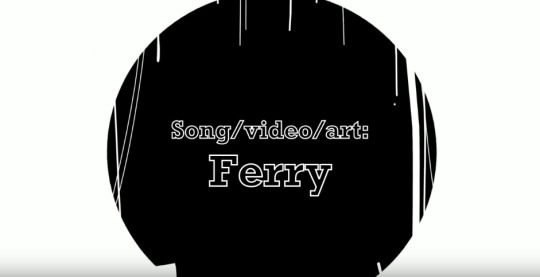


the meat grinder!!!! everyone’s favorite fucking hellhole!!!! it is only semi-explicitly identified in the song but that’s because it’s a concept from the source material - both tarkovsky’s stalker and roadside picnic feature the meat-grinder, as a location nicknamed thus by stalkers because it is even more fucking deadly than the rest of the zone, all of which is already ridiculously fucking deadly, and if you’ve seen the movie:

it is more or less instantly recognizable in the mill as well. so here we have a circle! here we have a mill (the title has about seventy double meanings but this is certainly one of them,) and as it turns out, this mill at least will absolutely kill you. and horribly too. interestingly though, in roadside picnic (the book) the meat-grinder is not a tunnel, and it’s not round - it’s just a nondescript patch of ground which will wring you out like a dishcloth and kill you extremely dead if you walk into it. on the other hand what we have in the book in terms of circles is the golden ball, which is the equivalent of the movie’s the room, which is, well,
in short both stories ultimately hinge upon the idea that there is a something in the zone which can give you your heart’s desire. anything you want. everything you want. whatever you want. it is infinitely powerful; it is infinitely capable. the catch is that it will only give you what you want. the catch is that giving you what you want is not the same as giving you what you are asking for. the other catch is that in both cases you have to get through the meat-grinder first.
(so, by the way, what the fuck, right? does pafl’s zone have a wish-granting factory? is it also behind the grinder? where were the original trio going when they got themselves fucked up? and did they get there?)
but the point is: the golden ball, the wish-granting factory, is also a circle. it’s just sort of a sphere. it’s a big round fuckin yellow thing. you know, sorta like:

which is THE ONLY TIME yellow is used in occam’s razor not counting the full-colour shots, and it drives me CRAZY, but it is also me going full conspiracy board so let’s not even worry about it. THE POINT IS.
the circle is the death-machine and the wish-machine. neither of these things are really.... very good. the circle, or at least the arc, is also very closely associated with death:

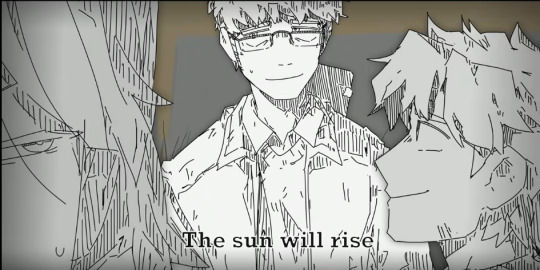

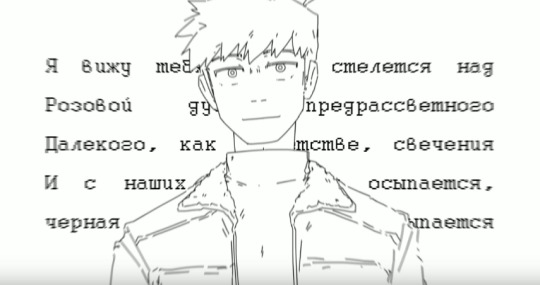
(розовая дуга предрассветного, ‘rose arc of pre-dawn’. if i’ve fucked up that nominative please feel free to stone me to death!)
in the gdoc notes to message lost ferry briefly refers to the dawn as if it were a good thing, the dawn of hope, which is a usage that sort of agrees with the desolate and deathless hope of strike 3′s ‘everything will pass / a day will come,’ but on the other hand it really is very closely associated with dying. nikolai bites it; nikita bites it; sergei and olga left significant chunks of themselves behind. and the thing about ‘this too shall pass’ is that it’s always true, as is ‘everything ends’, but of course that’s ‘cause the thing that ends might be you. and as we know

dawn is an ending. so that seems concerning!
i think the circle, the arc, the bolt falling back to the ground, is not a good thing. i am getting a little conspiracy board here in general but forgive me, i cannot make you a wholesome answer, my wit’s diseased. i think the circle is an enclosed space. it’s an unbroken cycle. it’s the grindstone. it’s the mill. it’s about what pafl’s always been about: about being trapped, about having no chances, about being bordered upon. the circle’s the geometric figure of equidistance from a given point, and you can walk on it forever, and nothing will ever change; you will never get closer, you will never get further away, you will never get out! the sun rises, the sun sets, and you are no closer to anything you wanted. it’s worth noting that anya’s borderline city, the zone-edge port town she complains is trying to crush all her dreams, her mill

is a circle. (a cog in a machine! a grind-wheel! a cage!)
and yura, whose dreams have already been burned out of him, who starts the series already resigned to never getting out of here, calls it ‘this dire deja-vu’, i am specifically resisting putting the accent marks back onto that, which is to say, it’s a repetition that haunts him. it’s going round and round and getting nowhere.

so if we bring it back around: drawing a line in the sand, as the phrase is generally used, means setting a border, means saying this far and no further. often it’s yourself you’re setting the border for. you hit some divide you can’t abide crossing so you say this stops here, it may be too early or too late, but i say it stops here. so logically: drawing a circle in the sand means you’ve locked yourself in completely.
I’ll draw a circle in the sand, drive myself around the bend in a desperate attempt to hold your battered hand
the whole first half of this song, i think, is olga promising to grind herself down in a hundred ways if it means she won’t be left alone. how hard can it be to never let it overflow? she may feel lower than the low, she may wish she could just disappear out here, into the postindustrial rust, but though it gets harder all the time she will keep pretending. she isn’t going to burden sergei, or indeed anyone, with her problems, her fears, her scars. she is hurt, but she’s used to it, she’s gotten used to being haunted long ago. she keeps her bad eye covered. she stays within her circle she has drawn. she keeps going round and round. she will take the smallest sliver of human connection and be happy, she promises she will be happy, she promises she won’t ask for more, she will take just the ‘hello.’
but you knooooow it’s not true. you know it’s grinding her down, that she’ll be milled to nothing pretty soon, and really she knows it too.
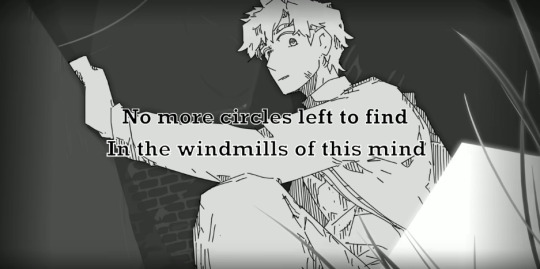
i am perhaps seventy percent sure that this line is a reference to the windmills of your mind by michel legrande, which features such lines as
Like a tunnel that you follow to a tunnel of its own Down a hollow to a cavern where the sun has never shone Like the circles that you find in the windmills of your mind
which on one hand seems sort of obscure to be a purposeful reference but on the other hand would be a hell of a coincidence if it wasn’t, wouldn’t it. either way it characterizes circles ambiguously, but definitely unsettlingly. going around in circles is chasing infinity, but what in god’s name would you do with it if you caught it? what are you even hoping to accomplish? and:
the second half of this song is bitterer, sharper - staring down the mouth of the meat-grinder she’s a little more willing to admit to herself that this is going nowhere. she is running out of cages to keep herself in. she is very tired. it’s easy to say why don’t you leave it all behind, it’s easy to say, she’s strong enough to let it go, it’s easy to say, too strong to die. it is a lot harder to actually live.
this is also where the flashbacks admit to us how badly hurt they really were - sergei with his whole side in shreds, she still hides her eye but at least we get to see it’s bleeding. this moral compass is forever misaligned, she says, so there is damage, and it is lasting. and she can’t settle for hello, she can’t live like this, she needs someone by her side. the trouble is whether she can believe she has any hope of getting that
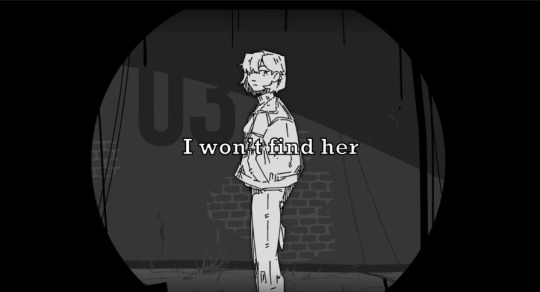
as for who ‘her’ is, or the ‘she’ of ‘she is bathed in youthful glow’, i figure there’s two possibilities: either it’s nadya, who haunts olga too, because nikita’s abandonment of nadya represents exactly what she most fears for herself, or it’s olga’s younger, unbroken, binocular self - both of whom were so young, and so easily hurt, and are now unfindable.
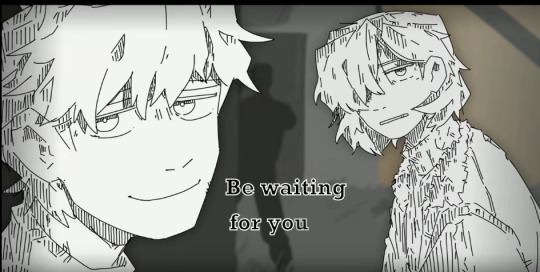
and then there’s this conclusion: ‘the sun will rise, until then / i’ll be waiting for you on the other side.’ which maybe is a sort of hope after all? she’s reached no real conclusions in the zone - she knows there must be hope but she can only barely believe in it - she thinks she is destined to self-destruct. but on the other hand she still has that, a version of sergei’s own ‘a day will come’
you may be hurt, but if you can hold yourself together, you can hope for a dawn someday. an ending. a change. but the trouble’s that there’s more than one kind of ending. and there’s more than one meaning for other side. there are cages, and then there are cages. and you know what else looks like a tunnel, a circle?
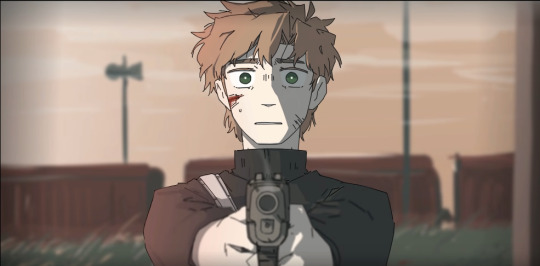
staring down the barrel of the gun.
#pafl#parties are for losers#it speaks#ask#in all fairness and in my defence when i made the joke i said i would write not less than one thousand words and by fuck#this has not been less than one thousand words!#jorgyjuice#THANK YOU FOR THE ASK ALSO THIS WAS REALLY FUN#and thank you VERY dearly to anyone who takes the time to read all this; you own my soul now; feel free to collect at any time#metatext
66 notes
·
View notes
Note
no pressure to answer rn but What r those opinions on representation in the experimental era owo
YESSS okay well if i went through each film individually i think id be here for a good few days. so i'll try to keep it brief as possible. also since we're talking about people of color im probably only gonna mention emperors new groove, atlantis, lilo and stitch, and brother bear since everything else was either exclusively white or about like. animals or something. though im sure something can also be said about coding john silver to be considerably darker than the other characters in treasure planet but i'll have to think about that a little more
a very general trend, i would say, is that since a lot of experimental era stories are characterized by NOT being based on public domain content or fairytales, so the decision to make the characters be of color seems less like an obligation as it did with their older films like mulan or aladdin. and i think that sort of lends itself to how pretty much NONE of these four movies seem like classic "disney" movies or even by the same studio when you put them side by side. there was a looot more experimentation with style instead of disneys sameface so a lot of the characters actually seemed to HAVE ethnic features instead of being the same cgi template that sort of just looks like elsa or rapunzel but Brown. i really love this era in general specifically because all the movies seemed to be doing their own thing stylistically. id argue that creative freedom also ended up bleeding into showing different cultures in their stories too for this era at least
ohhh man okay well im gonna talk about atlantis first because it is SHIT when it comes to representation its a horrible white savior narrative. i do still like the art style, a lot of the side characters are interesting but they are all ultimately just that. side characters. kida herself is horribly sexualized and reduced to a plot device + love interest DESPITE initially showing hints of a personality before turning into said plot device but you know. anyways representation-wise atlantis is a white savior story through and through but i think what makes that sting more is that an INSANE amount of thought was put into literally every other aspect of the film. they literally got the guy who invented klingon for star trek to make up the entire language of atlantean for their 90-something-minute movie, only to have it barely show up or even get mentioned in the final thing. the first two acts of the movie and original script were 2 hours and 150 pages long, respectively. but they didnt give a shit researching about any specific culture for the atlanteans it makes me so mad. BUT i think atlantis is important to address talking about representation in this era of disney because its just a really good lesson on what not to do lmao especially in the sense of making a character ambiguously brown.
OK emperors new groove. i could go on forever actually. especially considering the original version was supposed to be kingdom of the sun which was this huuuge fancy traditional disney-style musical about kuzco falling in love with some peasant girl (if youre curious about that btw definitely check out the documentary the sweatbox! its on youtube), and i think ultimately turning the movie into a comedy is what saved it. i think there would have been a lot of issues with representation had it actually tried to be a renaissance-style story. but INTERESTINGLY ENOUGH. this movie actually sparked a debate on indigenous land rights, because the original ending had kuzco raze a rainforest to build kuzcotopia, and sting, who worked on the soundtrack, ended up pointing out how insensitive that is particularly because the story features indigenous south americans even if the movie's not a "serious" one. i absolutely hate when this movie gets compared to el dorado just because they came out the same year and feature indigenous south americans and theyre both "haha funny" because emperors new groove actually Did end up sparking a meaningful discussion on indigenous portrayals, surprisingly, AND it doesnt have a horrible white savior story or sexualize any brown people. that being said though it does still have the trope of a person of color becoming an animal. i think its like...easier to forgive here given the story context but like. still a tiring trope. -_- SO YEAH while this movie is obviously NOT a pinnacle of representation i find it really interesting how it basically set the stage for turning to cultures that arent white for their stories even before lilo and stitch ended up truly opening the gates for that in mainstream animated films.
and lilo and stitch i believe ive already sort of given a rundown on hfkjghkj but i do always contrast it with brother bear in the sense that lilo and stitch had a story that was built around the culture they decided for the movie, while brother bear quite LITERALLY had the inuit culture slapped onto the story. like would you believe me if i said the original story for brother bear was based off king lear. and it was about actual bears, not a guy who turned into one. one thing especially that i compare with these two movies is that lilo and stitch had an actual hawaiian chorus for their songs, while brother bear had phil collins and a BULGARIAN WOMEN'S CHOIR for the transformation sequence. because they thought it sounded "mystical" and "foreign" enough it makes me sooo mad. and of course the trope of a person of color becoming an animal again. yeah i dont have tooo too much to say about brother bear's rep mostly because of how last minute a lot of the movie's decisions regarding it were. i also need to point out this is michael eisner's fault as well. he wanted more films about animals because he wanted to relive the success of the lion king, so we ended up with something that was made even worse in context because it was supposed to be about Just Animals and then the idea of putting people of color in there was added in afterwards.
UMMM so my general consensus of representation in the experimental era is that i think emperors new groove actually surprisingly opened up the idea for it but then lilo and stitch ultimately ended up bringing it more mainstream. but atlantis and brother bear are both important to look at too because they show how ultimately, this era was about disney trying to relive its renaissance glory INCLUDING the racism from that era. but more creative freedom in the 2d departments because of the supposed "death" of 2d animation ended up allowing for some freedom in storytelling too even if it wasnt always necessarily Good representation. okay hopefully this all makes sense bye <3
14 notes
·
View notes
Text
I rewatched The Ritual the other night for the first time in a while and am officially Back On My Bullshit, which means lots of thoughts and opinions that I am now going to make everyone else's problem. So without further ado, here are my thoughts on The Ritual's themes, character dynamics, and how the movie (in my opinion) improved upon the book
(spoilers for both the book and the movie)
Themes
So what is The Ritual actually about? I mean, obviously it's about a freaky forest monster that kills people and grants one of those kinds of immortality where you really gotta read the fine print, but underneath all that what is it actually about?
The answer depends a bit on both whether you're talking about the book or the movie, and how detailed you're being about it. Both the book and the movie share the very broad theme of "moving on", but what the characters are "moving on" from is different in each. I'd argue that the book primarily deals with moving on from past chapters in your life- cherishing the good memories, acknowledging and accepting the failures, and moving forward without becoming stuck on either.
The movie, on the other hand, is very explicitly about trauma, pain, and grief, and the process of confronting and moving on (or NOT moving on) from those experiences. This is achieved by the introduction of Rob, a character who didn't exist in the book. His actual appearance in the movie is brief, but his death is the driving force behind the entire movie. It's sudden, violent, and senseless, and it provides a very distinct and viscerally present context for the character interactions moving forward (more on that later). Rob's death faces the characters with a complex, heartbreaking, and traumatic loss and allows the movie to explore what it means to confront and move on from something like that, as well as the consequences of NOT doing so, by making that pain and grief into a very real (and beautifully designed) monster.
And that's where the movie's second major change comes in: the portrayal of the cult. I.... admittedly didn't really care for the cult portion of the book all that much honestly. It wasn't bad and some of my favourite lines were actually from that part of the book, but it felt almost jarringly different from the first part of the book to me. I felt like the heavy metal teen cultists were very much at odds with the sense of sinister supernaturality the first part of the book had spent building.
I loved the cult in the movie though. These are people who worship the personified (monstrified?) pain and grief that stalks the forest. They were chosen to survive specifically because of their own personal pain ("why me?" "Your pain is great") and by worshipping the monster they're kept in the forest and granted an immortality that saves them from death but not decay. It's a beautiful look at the consequences of being unable/unwilling to move on from pain/loss/grief and instead being consumed by it. The cultists are defined by their pain to the point that it eventually warps them into something almost unrecognizable. By worshipping Moder they are literally unable to move on, both physically (they're stuck in the forest) and spiritually (they can't die). Whereas the cult in the book felt jarringly different in tone from the story leading up to it, the cult in the movie tied into the theme beautifully and provided Luke with a look at his future if he allows his own pain to consume him.
Which brings us to....
Characters
A stories themes are often best portrayed through it's characters, and in this case that mostly means Luke.
Luke in the book is....well, to be honest, he isn't really that sympathetic or even that likeable when we first meet him or really for a large chunk of the story, at least not in my opinion. He's a 36 year old man-child who's clearly still chasing the glory of his college days and who's life up until now has mostly been characterized by failures, flakiness, and not taking responsibility for any of it. And on top of that, he's angry. The kind of angry that's violent, easily provoked, and generally unwarranted. All of the characters are facing failures at the end of this chapter of their lives to some degree (such as Phil being separated from his wife), but Luke is very clearly the least well adjusted- and least sympathetic- of them. His character arc revolves around him learning to move on from this previous chapter in his life, accepting the good and the bad and finally being willing to move forward with determination. In the beginning of the book Luke is characterized by indifference and petulant anger that masks fear and doubt, but he ends the book with a desire to move forward and determination to survive.
The inclusion of Rob and his subsequent death COMPLETELY changes Luke's character though and, in my opinion, makes him FAR more compelling and sympathetic. We still get similar notes to where he starts out as we did in the book; whereas Rob, Dom, Hutch, and Phil have all clearly settled down and moved on from their uni days, Luke obviously hasn't. This is made clear in his suggestions for the lad's holiday, his wanting to get a bottle of liquor after they leave the bar, and his conversation with Rob when they're in the liquor store. Movie!Luke really isn't all that different from book!Luke in the first scene or two.
Rob's brutal murder profoundly changes Luke's character though. He's left dealing with the grief and loss left in the wake of Rob's death, as well as the guilt associated with not having been able to stop it. By taking a character that may not otherwise be particularly sympathetic or likeable and having the audience watch him experience a deeply horrifying and traumatic loss, the movie makes Luke into an extremely compelling character and set him for a far more emotionally engaging character arc as he struggles to cope with both his grief and his guilt.
As I mentioned above, the cult in the movie provides Luke with a glimpse of the consequences of allowing his pain and grief to consume him. Now, the cult in the book sort of does the same thing- the indifferent anger and violence of the cultists mirrors Luke's own anger covering his fear and doubt and shows what could happen if he embraced that part of him. But the cult in the movie, in my opinion, works far better in this role because they feel more thematically and tonally in line with the rest of the movie and because Luke is a more sympathetic character. His decision to accept or reject that path carries more weight because we care about him. Moreover, accepting the same path as the cultist would provide him with a community that understands his pain, something he very much did not have with his friends; we understand that accepting the cult is a bad decision, but we also understand why Luke would be tempted to do so. Simply put, we feel for him and that makes the presentation of this choice much more emotionally impactful.
Interestingly, Luke's character arc in both the book and the movie end with him developing the desire and determination to survive. It comes from two very different places though. In the book, it revolves around Luke's willingness to finally close out the previous chapter of his life- highs and lows and all- and move forward into the future despite the fear and uncertainty doing so may provoke.
In the movie, though, this decision comes within the context of Luke's survivor's guilt. He feels guilty over Rob's death because he wasn't able to intervene and this guilt is reinforced by the other characters, most notably Dom and, later, Hutch. His decision to reject Moder, to fight back and refuse to kneel, represents not only his decision to move on from his grief and trauma but also the acknowledgement that despite what happened he still has worth and his life is still worth living. It also resolves his struggle with his inability to help (which plays a large role in his guilt), something that comes into play in all of the deaths in the movie even beyond Rob's. In Hutch's death Luke tried to find him but was unable to find him until it was far too late. In Phil's death he's initially paralyzed before running away, both in fear, in much the same way he did in Rob's death. In Dom's death he was able to take the necessary steps to help Dom (dislocating his thumb to get out of the restraints) but was ultimately too late and was forced to watch Dom die anyways. By recognizing that he still has worth and that is life is worth living, Luke is able to act in spite of his fear and make the decision not to allow his grief, pain, and trauma to consume him.
No discussion of Luke as a character is completely without also discussing how he interacts with the other characters and hoooo BOY did the movie really ratchet those interactions up a notch or ten. The interactions in the book were well written but they admittedly felt a little one note at times (though this is also probably somewhat due to me viewing book!Luke as not particularly likeable or sympathetic). By including Rob's death the movie adds a layer of complexity to the character interactions that I felt really wasn't there in the book and we get to see the interpersonal effects of traumatic loss. Luke may have been the only one to witness Rob's death but they're all grieving him, and we get to see how that (and how Luke's friends' perception of his role in Rob's death) impacts and strains their relationships. As I mentioned earlier, we see very clearly that Luke doesn't have any real support or understanding from his friends; Dom does little to hide the fact that he views Luke as directly responsible for what happened and while Hutch does initially attempt to provide support, it comes off as superficial and he later admits he isn't sure whether he blames Luke. Luke is very clearly struggling with what happened but can't turn to the people he would normally rely on for support, and his interactions with his friends often alienate him and further reinforce the guilt and blame he's grappling with rather than provide any source of comfort. This, again, makes the temptation to submit to Moder and join the cult, to give into his pain and grief and loss and let it consume him, that much more compelling and his choice to reject it that much more meaningful.
Overall, the movie's decision to add in Rob and his subsequent death and to change how the cult was portrayed was, in my opinion, a truly excellent one and helped move the movie from a story I would've enjoyed but shrugged off into legitimately one of my favourite movies of all time. It allowed for a more thematically and tonally consistent story and made both Luke and his character arc more sympathetic, compelling, and emotionally impactful. When it comes to adaptations I generally tend to enjoy the book more than the movie, but this is one of the few exceptions where I truly believe the movie significantly improved upon the book
#listen I know I'm just screaming into the void on this#but I have SO MANY thoughts and feelings about this movie#I love it so mcuh#the ritual#the ritual 2017#the ritual movie
66 notes
·
View notes
Note
How do you think French Fantômas and Mexican Fantômas would react if they discovered the existence of each other ?

It's a very amusing coincidence that the timelines for these two actually align almost exactly in where one ends and the other begins. Fantomas's original canon takes place around 1909-1913, but Allain wrote Fantomas stories all the way to 1963, and while I can't get my hands on those or even find them for purchase, he's presumably never bothered to explain the time that's passed. Then, circa 1964, we have the Jean Marais blue faced Fantomas from the parody film. And then, circa 1966, Novaro Editorial starts publishing Fantomas, adapting the original stories and sort of mixing the two Fantomas together. And interestingly, the stories actually do demonstrate this shift happening.
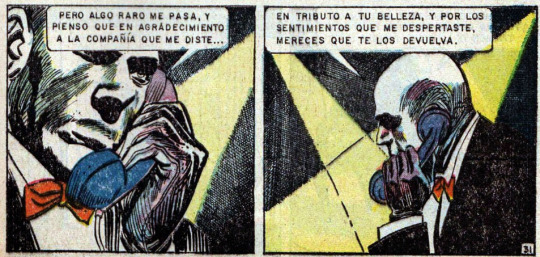
When Novaro started publishing Fantomas, they ran with the original version for about 9 stories. You can look at the image above and see that Fantomas was very much still intended to be the sinister villain, even if he started off much less horrible than in the novels since, by this point, the parody Fantomas from the film was still the main influence. And then we hit issue 10 in a story called Fantomas contra Fantomas, presumably based on the 1949 serial, and the story for the most part is like all the others. Lots of people talking, policemen fumbling around, Fantomas on a screen/phone talking to henchmen, and so forth. But there's something very different about this story, and it's Fantomas himself. You'd think that the transformation from novel/movie Fantomas to comic book would be some kind of gradual process, and that's what I assumed it was, until I read the comic.

And it's literally just two pages. In one page he's a sinister blue-faced being commanding orders to his henchmen, and the other, literally from one panel to the other, he goes from the blue-faced Bond villain from the film, to a quiet and contemplative man resting in an armchair playing around with his cat waiting for pieces to fall in place for his new game. And indeed, the whole story ends with Fantomas handing the fake Fantomas behind the current crimes to the police, with a final letter that is pretty out of character for the original Fantomas, but much more in line with the characterization he would take going forward. This story draws a very clear line in the sand: Out with the old and busted, in with the new hotness.
You wouldn't be that far off in assuming that Fantomas's redemption arc started simply because he got a cat.
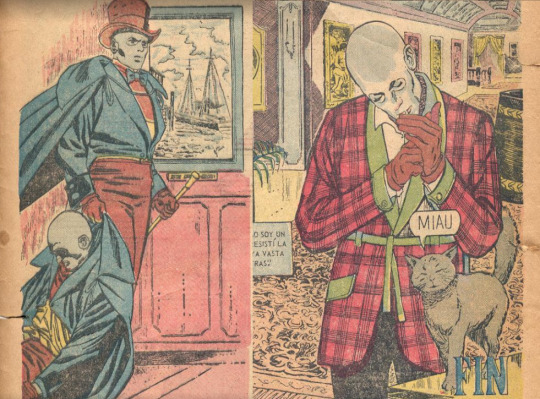
Dear journalists and Inspector Gerard: In front of you is the real thief of famous paintings. I was fine with him using my name, until he mistook a bad copy for an original.
I am a cultured man and a connoisseur of art: whoever cannot distinguish a true Cezanne is an idiot. He also did not commit the robberies because he was an art lover, but for money, and because he did not care that the paintings left France.
On the other hand, I make it known to you that the stolen Courbet has been returned into the hands of it's owner. I dislike making moves against poor people.
As for the other paintings that were stolen by the wretch that I left tied up, I must confess that, as I am in love with them, I could not resist the temptation to enrich my already vast collection of masterpieces.
The very next story, Fantomas steals a time machine to try and steal a ruby that once belonged to Genghis Khan, and after a bunch of adventures through time, he ends up failing. Two stories afterwards, Fantomas takes a look at the world, it's nukes and weapons race and the elites and politicians furthering it along, and states he's never had a bigger challenge than solving that, and decides to fight for world peace. So he assembles a league of the world's greatest scientists and fakes a message from aliens to all the world leaders telling them to dissassemble the arms race and instead divert all their resources to fight for the preservation and progress of the human race, and it actually works.
He tells the scientists that, although he is not considered a noble man, the magnitude of importance in this mission inspired him, later privately confiding to his cat that, actually, the real reason he sought to bring world peace was so war couldn't interfere with his plans. Fantomas pulled off Ozymandias's goal literal decades before Watchmen, and he did so without spilling a drop of blood. I mean, not that it lasted, obviously, but it was very clearly a different direction than what had been done with the character before, and this was going to be the direction going forward.

These stories are set in France, by the way, actually a lot of the Fantomas comics allude to the stories taking place in France. Sometimes they take place in France and sometimes they take place in some fake city and sometimes it's just Mexico, the latest stories seem to be pretty firmly set in Mexico, and the character's a globetrotter so he goes everywhere.
So really the question isn't how they react if they'd discovered each other, because you'd be hard pressed to find two characters less compatible and less willing to tolerate the other's existence. If these two exist in the same world, there is no way they don't know of each other at the very least.
How can French Fantomas possibly maintain a career and legacy as a mastermind of terror when this globally famous do-gooder keeps going around fighting crime and opression and acting as an ambassador for peace and goodwill and progress? How can the Mexican Fantomas possibly do good in the scale he must, or even get away with the odd mischief, if he bears the name and legacy of a globally infamous horror who drowned France in the blood of men, women, children and animals for years? What will the legacy of the name Fantomas be to the world?
It's a very clear Ultimate Evil vs Ultimate Good, past vs future conflict here, the old gothic serial killer vs the new sexy superhero, the two having very clearly defined worlds that are wholly incompatible, that you'd have to drag them outside of in order for this conflict to play out and risk undermining both characters.
The two things they have in common besides a name are the very clear storytelling precedents they share. One is, momentary disguises and diversions aside, there is only one Fantomas. And the other is the hardline rule of their universes: Fantomas Always Wins.

But how can Fantomas always be the sole victor, if he's not even the sole Fantomas?
Clearly one of them's gotta go.
Actually, I just discovered there WAS a Mexican Fantomas story detailing the two meeting. It was called “Uncle Fanto”, and it’s about an elderly Fantomas coming to visit his nephew, until he falls and busts a leg, and everyone laughs at him when he claims to be Fantomas, and Fantomas explains that his uncle misused his virtues for the sake of evil, and was incarcerated 20 years ago, and since then he’s been cleaning the name. Uncle Fanto’s looking for him because Allain has died and he has nothing left.
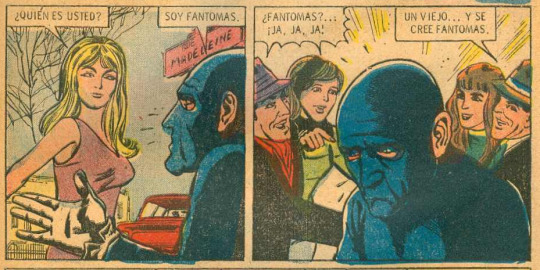

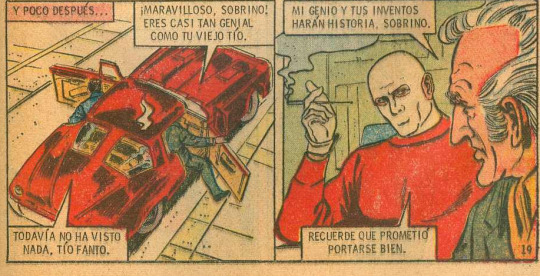
My genius and your inventions will make history, nephew
You recall that you promised to be on good behavior
And the story ends with Uncle Fanto getting stopped from an attempt to do one last crime, and promising that he won’t go back to the way he used to be, so Fantomas takes him to Professor Semo, who applies a memory-wiping treatment, fixes his knee and renews his agility (Semo is definitely my least favorite part of these stories because goddamn the guy is sketchy). The story ends with Uncle Fanto racing a robot.
Obviously this is a very “tame” take on this story and the original Fantomas, who’s presented here as mostly a robber and criminal mastermind (and he’s said to be sixty years old in 1971, which means he would have been born in 1911, so he definitely could not be the original Fantomas), and not the one I’d go with if I put these two together, but it’s the official one. It’s perfectly in line with the reocurring trend of the Mexican Fantomas finding ways to redeem villains and give them second chances.
Maybe he himself was a second chance for the original Fantomas.
31 notes
·
View notes
Text
I agree with you. I'm also 100% sure that director James Gunn planned to do this a long time ago, at least since the second volume, very obviously. Besides the fact that this is his last Marvel movie, I think it is more important that he loves his characters very much, especially Rocket, Nebula and Peter Quill. These three characters in the trilogy have an inherent solid structure like a triangle. In characterization, they have common and complementary points , balancing character and plot. Even if the third volume is not the last Guardians of the Galaxy movie, even if all the Guardians are still on the same team, it is still difficult to see Nebula and Peter Quill as a real pair on screen. I think maybe the director did his best to drop all kinds of hints. Replacing a lead in a romantic relationship is always difficult, and that goes for the whole world. Especially when the former is the protagonist and "shining hero" , and the latter is the supporting character and "hated villain", even if she or he used to be.
I only noticed this ship because I had come across a very similar example before. From the structure and writing style within the story to the audience's reactions and arguments outside the story, it was all very, very similar. That work was created much earlier, but even so, the hidden couple in that work were still not recognized by the mainstream, leading to all sorts of objections and attacks that their ship now has to deal with online. And their film and television works have also had to be edited and adapted to suit the tastes of the public. Interestingly, the fever of hidden couple has been rising in the homo forum, and the enthusiasm for discussion has continued unabated. It also shows me where the potential is for the Nebula / Quill pairing.
Sorry to hear that,but I don't know much about the movie and the couple you mentioned, I'll find time to learn more about them, thanks for the references.
The Nebula /Peter Quill ship, was not destined to be accepted by the public at first for a number of reasons. Attacks would come from all directions. As more and more analytical articles and fictions become available, the acceptance will increase. This will take a long, long time. And it will hardly become mainstream.
Never expect a clear answer from the authors themselves.
There is nothing new under the sun. The same has happened and will happen again. The fun and the truth are waiting to be discovered.
That's what I learned from an almost identical thing.
29 notes
·
View notes
Text
The Critique of Manners: Part III
~Or~
A Somewhat Indecisive Review of “Emma” (Miramax, 1996)
I have a feeling this review is gonna be a little harder for me to write. Everyone knows that recaps and reviews are most entertaining when the writer has an intense dislike (or intense feeling of any kind) for the drama they’re reviewing. It falls to other writers to pan or praise this film as they will, but I simply don’t have many particularly strong feelings about it at all. I have neither that repulsed dislike for this movie such as I did for Emma 1997, nor that disappointed frustration as for certain aspects of Emma. 2020, but neither do I have a deep, profound love and appreciation for it as I do for Emma 2009.
Written and Directed by American Screenwriter, director and actor, Douglas McGrath, Emma (1996) is rather what one expects it to be: a 90’s romance film. Perhaps it’s because I had expectations due to the era in which it was made, but I think I have a tendency to excuse some of the problems with this film. There are many unnecessary additions (for comedy’s sake usually and often quite cringe-y) and one definitely can’t claim that the dialogue hasn’t been tampered with. I don’t normally side with the “I do so miss Austen’s biting wit” crowd but, by ‘eck I felt it this time. That’s because Austen’s Biting Wit™ just doesn’t suit a fluffy 90’s chick flick (which this film is in a way that other big screen Austen adaptations of the time just aren’t – and I think approaching this film from the 90’s chick flick perspective is probably the best way to digest it.) This version, more than any other (except perhaps 2009) brings the concept of Emma-as-Matchmaker to the fore with a particular emphasis precisely because it’s a concept that fits well with the rom-com style of filmmaking used here.
The bones of this review, like my review for the ITV version, were written six years ago following my initial viewing only a select number of portions survive from that review (which is still on IMDb).
As with all my reviews I'll be comparing the script, characterizations and plot to the book and commenting on the authenticity and attractiveness of the costumes, and suitability of the houses and sets.
Let’s dive in.
Cast & Characterization
Emma is arguably the easiest of Austen’s works to read because of Emma’s generally good (if condescending and overly self-confident) character, and Mr. Knightley’s sober, mature but exceedingly pleasant manner. I had my doubts about Gwyneth Paltrow playing an Austen heroine, but I at least had faith in Jeremy Northam’s ability to portray the mature Mr. Knightly. My expectations were not entirely disappointed in either case.
My prevailing feeling about this film is that it’s not so much set in Jane Austen’s Regency England, but in an American fantasy of what Regency England was like. Perhaps the biggest factor that reinforces this impression is (of course) the casting choice for our leading lady, Gwyneth Paltrow.
Freckled, ruddy and thin as a twig, Gwyenth didn’t quite, to my mind, fit the physical description of Emma, who is supposed to be “The picture of health” according to Mrs. Weston. Add to this the Regency beauty ideal of a soft and shapely figure with regular features. Fair hair was generally preferred (and I have always imagined Emma as blond, although I’m given to understand that Austen’s idea of pretty generally favored dark hair), so I can’t fault Gwynnie there. What I can fault though is her so-so British accent.
I recently learned that the reason McGrath thought Paltrow would be a good choice was because she’s the only Texan he’d ever met who’d managed to entirely throw off her native accent; I guess he decided that if she could do that she could do any accent work? I guess? Seems questionable to me.
You know Joely Richardson was considered for this part? Gorgeous, refined (British) GODDESS Joely Richardson was passed over because Gwyenth managed to shake an embarrassing accent.
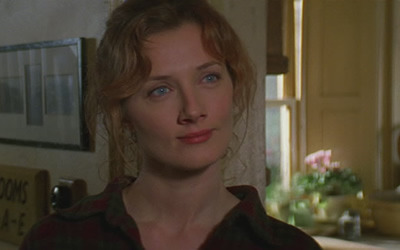
I hate American directors.
I’m not sure if it’s just part of the accent, or her attempt to sound upper class, but on this most recent re-watch it hit me for the first time how very nasal many of her line deliveries are. She also has this problem with looking (and sounding) sort of vapid and… just what is happening here?
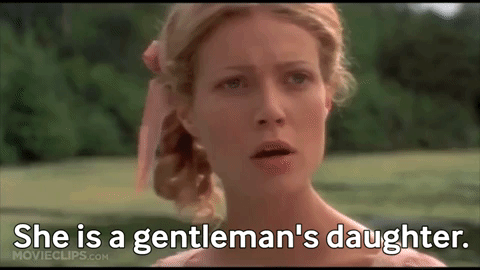
Is she having a stroke at the end there?
A bigger problem than Emma’s casting, however, is her characterization.
Part of the above mentioned script tampering is in lockstep with some of the issues with Emma’s characterization here. Her very teenager-esque swings from vowing to never make another match again to immediately trying to think of another guy to set Harriet up with, and her getting carried away in potential scenarios “But if he seems sad I shall know that John has advised him not to marry Harriet! I love John! Or he may seem sad because he fears telling me he will marry my friend. How could John let him do that? I hate John!” (Especially when you never even really get to meet John Knightley in this version? Ugh, pass me with this shit) is so bizarrely childish it’s a little hard to stomach. She spends the movie going back and forth between mature and manipulative to childish and naïve and it just… doesn’t work for me. Emma can be all of these things but the transition from one extreme to another here seems a bit disjointed to me.
Knightley was a bit of a disappointment to me in this version. That’s not Jeremy Northam’s fault because I can’t think of a better choice they could have made. McGrath showed much better judgment with his choice for Mr. Knightley than he did with Emma.
My biggest problem with this interpretation was how laid back he was when he was supposed to chastising Emma. Their quarrels became more like mere disagreements so the proposal line of lecturing her and her bearing it as no other woman would have isn’t entirely earned. Even in the big scene at Box Hill where Knightley is really supposed to lay into Emma, he starts off pretty solidly, but by the end so doe-eyed and apologetic it fails to deliver the sting of rebuke that is Emma’s biggest learning moment in the story. Perhaps they were trying to go for a more disappointed feel (the kind that makes you feel worse than being shouted at because you really respect the person you let down) but it just didn’t come through for me.
Also of note is the fact that, (I assume) because John Knightley isn’t really allowed time to be a character in this film, McGrath took some of John’s introverted tendencies and transplanted them into his more convivial older brother (“I just want to stay home, where it’s cozy.” – I mean I feel that, but this isn’t something George Knightley would say.)
Onto the less central characters
I question also the choice of Toni Colette for Harriet Smith. I mean I actually liked her performance more on this watch than previously but I just don’t think she’s pretty enough for Harriet, and she looks a bit clumsy (though that might have more to do with her costumes.)
I also noted that McGrath bumps Harriet’s comprehension skills up just a scooch. Emma never has to explain the “Courtship” riddle to her, Harriet figures it out on her own after a while, while she never manages to in the book.
Now we come to the crux of Jane Fairfax, played by Polly Walker. I don’t care for this choice. My issue is the simple fact that she just isn’t believable to me as a demure, wronged character like Jane Fairfax. Seriously she looks like she would sooner throw Frank across the room than take his cruel teasing, and not in the subtle way that Olivia Williams managed to. They never even utilized her by including some of Jane’s more pointed returns to Frank’s jabs, which they even managed to squeeze into the massively cut down TV movie.
Speaking of Frank; Ewan McGregor, though generally delightful, was so under-used. Frank and Jane’s plotline always kind of gets shafted in Theatrical release adaptations of this story. It’s not as bad here as it is in say, the 2020 adaptation (they were in that version so little I actually forgot what their actors looked like), but it’s still pretty stunted.
I find it interesting that Ewan McGregor himself thinks his performance in this movie isn’t good; and I’ll agree it’s not his best (certainly it’s no Obi-wan Kenobi) but I thought he did a pretty good job with obviously unfamiliar material
Also if the Davies screenplay of ’97 made Frank’s character too caddish, I think this version didn’t make him caddish enough. I mean he’s hardly around enough to really develop his flirtation with Emma, and they merged Strawberry Picking and Box Hill into one sequence so we never see Frank’s ill humors. I can perhaps excuse this, since it seems like a nuanced story really wasn’t what McGrath was going for here, I think. This is a lite version of the story; schmaltzy fluff for teenage girls’ movie nights. Frank’s ill humors wouldn’t really have fit the tone of this version at all.
Interestingly enough, though it’s taken me a long time to make this decision, I think Alan Cumming might be the definitive Elton? He’s the only one who doesn’t immediately read as a slime ball from the get go. I mean he’s got all the warning signs that Austen wrote into him, but no more than that. He’s not slinking about greasily or obviously pandering (at first), so Emma’s uneasy realization of what’s really happening here isn’t a hundred miles behind the viewer’s (maybe just fifty).

There are as many Mrs. Eltons out there as there are adaptations of this story, and they’re all pretty great (funky accents aside), but other than the 1997 take, this one might be the least great to me. She’s not nearly pushy enough, because Mrs. Elton would never let Emma prompt the conversation when she could do it herself.
Also, I think McGrath misunderstands Mrs. Elton’s brand of New Money vulgarity. He has her talking with her mouthful, clanking her utensils on her plate as she eats, putting biscuits which she’s bitten into back onto communal plates, which I think even Mrs. Elton would know not to do. Table manners are pretty basic; the couth that Mrs. Elton lacks is of a more nuanced social kind – for instance, what is and isn’t considered gauche to talk about (like how big one’s brother in law’s house is or how many horses he keeps.)
(A sudden thought has just occurred to me: is Mrs. Elton just a more mean-spirited Hyacinth Bucket from Keeping Up Appearances? “It’s meh sister, Mrs. Suckling! That’s right, the one with an estate in Warwickshire and the two barouche landaus!”)
Sophie Thompson’s Miss Bates is chatty and one of better takes on the character, but lack of necessary background hinders her impact on Emma’s story. The comedy in her scenes is some of the best and actually made me laugh, although I think she was just way too giggly.
Miss Bates’s mother, Mrs. Bates, is played by Sophie Thompson’s real-life mother Phyllida Law in a completely coincidental quirk of casting. (I noted in this film how very much Emma Thompson, Sophie’s older sister looks like their mother.)
My only other serious issue with characterization in this adaptation is the representation of Mr. Woodhouse. He is somehow simultaneously more cheery and more disagreeable than he is in the book. His chiding about the cake at the Weston’s wedding seems more like a scolding rather than an anxious admonishment. In one of the first scenes, during Mr. Woodhouse’s “Poor Miss Taylor” speech, he says he cannot understand why she would want to give up her comfortable life with himself and Emma, to have “mewling children who bring the threat of disease every time they enter or leave the house,” and he says this IN FRONT OF ONE OF HIS TWO DAUGHTERS.
Of course in the book, Mr. Woodhouse does lament Miss Taylor marrying, leaving and even having children – but this is all in the context of the danger childbirth presents to Miss Taylor (And the fact that he can’t stand losing a companion). These are his complaints – not the children themselves. In addition, his elder daughter has quite a fine number of children, all of them very young, of whom Mr. Woodhouse is very fond. He’s a character that needs to be carefully handled because, much like his daughter, it’s very easy for him to become unlikeable.
For the rest of the time, though, he just sort of cheerily laughs and is very at ease, when Mr. Woodhouse, as a chronic hypochondriac should be made anxious by just about everything.
Sets & Surroundings
One thing I find interesting about this adaptation is that the houses they chose to use are all of a very neo-classical Palladian style, which I believe (given her disdain for the contemporary trend of knocking down England’s great houses just to rebuild them in a more fashionable style) Austen may have disliked to some degree.
One such house is Came House in Dorset, which was used as the Woodhouse’s estate, Hartfield. Now Hartfield is, I think, described as a well-built modern house so this could be pretty accurate (although Modern could refer to the red bring, boxy style of Georgian architecture, such as the houses used in the 1997, 2009 and 1972 versions.)
Another, Claydon House in Buckinghamshire played the role of Donwell Abbey. I think this might be the worst exterior ever used for Donwell, from a book accuracy perspective. Utterly Georgian, with its’ square façade, Claydon house sort of directly contradicts Austen description of being “Larger than Hartfield, and totally unlike it, covering a good deal of ground, rambling and irregular…” not only is the architecture totally wrong, so is its’ situation, in Georgian fashion, perched on a hill, when Donwell (a very old building) is supposed to be “Low and sheltered”.
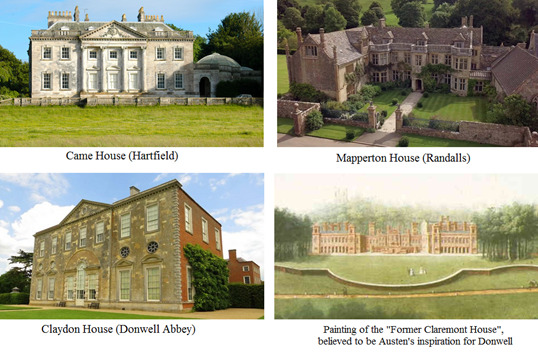
Mapperton House is maybe the grandest house yet used for Mr. Weston’s Randalls (I’ve already covered in my review of Emma (2020) why this is a problem – although in this version, as in the 1997 adaptation, there’s no full panic over the snow, so this is less of a problem, but a house like this is still too grand for the reasonably sized Randalls of the book), but it fits the usual 15th-16th century house type that always seems to be used for Randalls.
A myriad of other great houses were used for interiors, however other than Crichel House (Dorset), which was used for Donwell’s interiors, I can’t find information on which ones where used for what. They include Breakspear House (Harefield), Coker Court (Somerset), Stafford House (Staffordshire) and Syon House & Park (Middlesex).
I really appreciate the interiors which were all very colorful and even included doors and molding painted the same color as the walls which is a very Georgian decorating convention, although it looks odd to the modern viewer.
Costumes & Hair
As a rule, the costumes (Created by Ruth Myers) in this movie are pretty damn good, composition wise, but the arrangement leaves a lot to be desired. Myers talked extensively of wanting the costumes to be colorful and bright like the water colors of the time, which she achieved brilliantly. What I find funny is that she talked about using color as if it would be controversial from a historical accuracy point of view, which couldn’t be further from the truth.
The evening wear is generally excellent
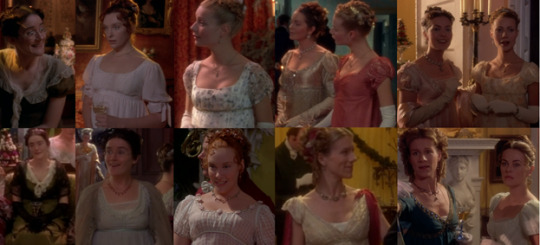
My only question around evening wear here is… what’s up with the waistline on Harriet’s ball gown? Why is it going up in the middle? Toni Collette (who actually gained weight for the role, since Harriet was described as “Reubenesque”) verged on looking a little dumpy throughout the film and awkwardly bumping up her waistline in the middle really didn’t help.
I’m pleased to report that is is the one version where Miss Bates’s evening-wear is allowed to look like evening wear. Even Maiden Aunts wore shorter sleeves and lower necklines at dinner or balls. They fussed her up with some lace gloves and frilly fichus but it follows the conventions of the time. I appreciate that immensely, though I have the sneaking suspicion that it’s because of Sophie Thompson’s age.
At 37 Thompson was an unconventionally young choice for Miss Bates, a character who previously had only been cast as older than 50 (Prunella Scales, who would play the role later in 1996, was 64). Indeed, Douglas McGrath almost passed Thompson over for the role on account of her age, but reconsidered after seeing her in spectacles. It seems possible to me that since Thompson was considered young they dressed her “young” as well.
The daywear is where the costumes start to really fall apart. There are a lot of looks here worn in the day that are VERY not day/outerwear appropriate, especially on Emma, most especially the yellow dress she’s wearing while driving that carriage (which, btw is inappropriate on a whole OTHER level). Can we just talk aboutt he cognative dissonance of bothering to put a bonnet on her when her arms and boobs are just hanging out like that? Like, it would almost have been less egregious to just leave the bonnet where it was.

But then there are a lot of Emma’s day-wear looks that are perfectly suitable and appropriate. What I find ironic about that is that most of the short-sleeved, low-necked “Evening-gowns as day-wear” looks are worn OUTSIDE in the sun and most of the long-sleeved, sun protecting, day-wear appropriate looks are worn INSIDE. She’s also got a profusion of dangling curls in day-time settings that are also more evening-wear appropriate (to match the dresses, perhaps?)
I’m also pleased to report that even in day-wear Miss Bates gets a break from brown in this version. Her clothes are nice, but not fancy like Miranda Hart’s in Emma. 2020, and I like to think that nice thick shawl with lace overlay is the one mentioned in the book that Jane’s friend Mrs. Dixon sent along home with her for her aunt.
My only problem with Mrs. Elton’s kit is that it’s all perfectly nice, but none of it is overly-nice. There’s no extra trim, no unnecessary lace, not even any bold colors. I hope Myers and McGrath didn’t take Mrs. Elton’s line in the book about her fear of being over-trimmed seriously.
Let’s talk outerwear. There’s a lot of going into town with JUST a shawl on in this movie (usually over short sleeves), and I’m sorry but I don’t think that’s how outer-wear worked in this time period. A shawl is good enough when you’re taking a turn in the garden but not for going out in public into town, unless maybe you’re wearing long sleeves, or perhaps paired with a SPENCER.
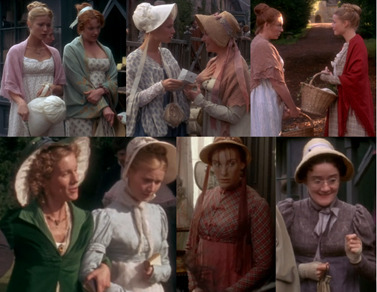
Never mind Mrs. Elton’s line about a shocking lack of satin at the end of the movie, I’m more concerned about the shocking lack of spencers. There are precisely three in this film. I counted (and the sleeves on Emma’s look like maybe they’re too long for her?) Mrs. Elton sports the only redingote in the film.
Jane Fairfax is, as always, in her classic Jane Fairfax Blue™,
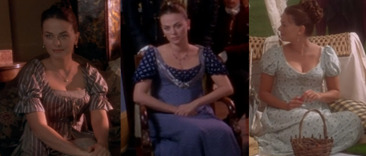
although she has some nice white gowns at some points too.
Now, onto
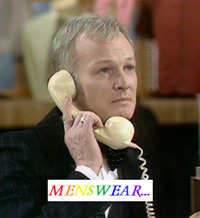
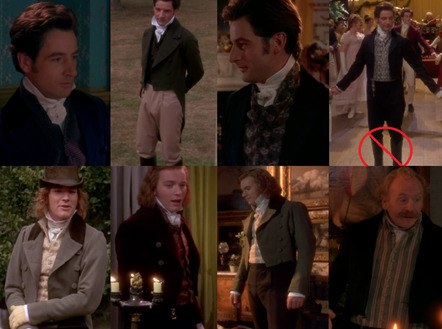
Definitely a bit more colorful than the 97 adaptation. Mr. Knightley benefits most from the addition of colors other than green. He’s even got some smashing waistcoats and a very nice blue evening coat (I couldn’t get very good shots of them though). The problem is; those trousers? NOT. TIGHT. ENOUGH.
Also… you all see it, right? I circled it in red so you should. Yeah. Knightley is dancing in boots. WTF RUTH? Please! You’re better than this! Who dances in Prussians like that? I ask you! (Frank also wears boots to the Cole’s dinner party so that’s two strikes.)
I’m not sold on Frank’s looks. His day-wear is a bit sedate for such a confirmed dandy (I believe he’s called a “coxcombe” in the book?) and his evening wear… well he apparently only has the one look.
And speaking of Frank’s look in this film, I’d like to know at whose doorstep I should lay the blame for what Ewan McGregor himself has called “The Worst Wig Ever”; and why the hair designer in charge decided to model Frank’s aesthetic on a theme of “Chucky meets the Mad Hatter”.
This hairstyle not only looks dreadful, it’s not at all fashionable or authentic to this time period! Fashionable mens’ hair styles at this point were all relatively short. A Beau Brummel coiffeur, or a short Roman style, or a fashionable head of curls like Mr. Elton’s! Not this farmer chic. Robert Martin’s hair is more fashionable than Frank’s!
The tune they chose for Emma and Knightley’s dance is a baroque melody (so a hundred or so years out of fashion) called “Mr. Beveridge’s Maggot” and as is pointed out in the video linked above, and is the same tune and dance used for Lizzie and Darcy’s big dance in Pride and Prejudice (1995).
I get why it was used in P&P because, slow, stately baroque tunes are often used as on-screen short hand for snobbish character like Mr. Darcy. It’s not super intense either, like the baroque tune used in P&P 05, which was chosen for more romantic effect. So why use this kind of “stuck up” tune for what should be a romantic dance? Maybe because it was used in the 95 P&P which became, almost instantly, one of the most popular Austen adaptations?
Quick note on the dancing and music in this movie. I’m not an expert on English Country dance (I’ll outsource that by giving you the usual link to Tea with Cassiane’s analysis on YouTube) but I’ll add my two cents - I know Cassiane gave this a pretty favorable three full dance slippers but I think the way all of the actors and dancers move looks very poorly rehearsed and kind of sloppy. I think everyone just spread out way too much.
Douglas McGrath’s Script
I have to say one of the things this film did very well and brought to the forefront is how insular Emma’s life is. The opening credit sequence brings this to our attention right away by showing a spinning globe which, once it slows down is shown to be, literally, Emma’s whole tiny world. Hartfield, Donwell, Randalls and Highbury. That’s it. It’s perhaps not a very subtle device, but it does get the job done and very succinctly too.
I would now like to talk about my issues with the script of this movie; I have some problems with it. Very different problems than it’s 1996 counterpart though.
First let’s go over the comedic device that jumped out to me most in this movie: the awkward pause.
I think it’s only used twice but they both bothered me.
First there’s the pauses while Emma and Mrs. Weston grill Knightley on whether he considers Jane Fairfax romantically. It’s all written as very “OoOoOooo” with Knightley answering their interrogations and then sitting between them awkwardly as they stare him down as, none of his answers giving either Emma or Mrs. Weston satisfaction. This is one of the most teen rom-com moments of the film to me.
Next there’s all the quiet stretches while Emma and Mrs. Elton have tea at Hartfield. I don’t like the use of awkward pauses in this case because (as I mentioned in Mrs. Elton’s characterization section) it’s so ludicrous to me that there are pauses in this conversation at all. Surely the point of Mrs. Elton is that she loves to hear herself talk and her conceited obsession with the idea that everyone around her must only benefit from hearing her opinions. There should be no conceivable reason why Emma should have to prompt conversation like she does in McGrath’s version of this scene, except to derail Mrs. Elton’s constant self-important yammering.
Watching it this time around I found myself wondering exactly what McGrath wanted to do with this film. I mean I’ve been attempting to decipher exactly whether the changes made were conscious and based on artistic vision, or whether they were changed because the source material just flew over McGrath’s Hollywood Director head.
I mean he gets the important plot points across, but there were other scenes that I had issues with: namely, the Archery scene. This is a pretty intense part of the book because Mr. Knightly goes from astonished, to indignant, to truly vexed with Emma in a short period of time. But this scene in the movie is very casual. The part where Emma’s arrow goes wide and into the general direction of Knightley’s dogs, and he takes an opportunity to make a quip and says “try not to kill my dogs” particularly annoyed me. My issue is that this totally ruins the tension of the scene; and why are Knightley’s dogs sitting BEHIND THE TARGETS ANYWAY? Knightley is a sensible man, and one who knows better than to let his dogs rest in a place where stray arrows could hit them!
The dialouge is very jarring because it flips back and forth beetween being alright, and period appropriate and then it will just spring a very modern turn of phrase and pull you completely out of the setting. I know this is something that’s been brought up with the 2009 version as well but maybe it’s because the actors in that version have (in my opinion) better chemistry that it simply doesn't stick out to me as much.
The comedy in general in this movie just makes me cringe a lot of the time (Sophie Thompson’s “oh sorry, napkin” bit notwithstanding). Like the soup thing when Emma and Harriet meet Mr. Elton after visiting the poor, and the random kid that gets tossed into this scene with Emma… just doesn’t work for me.
Wikipedia describes McGrath’s tweaks on Emma and Knightley’s banter (which really weren’t changed that much, textually) as “Enlivened” to make the basis of their attraction more apparent, which… I’m sorry but nothing about the exisiting banter isn’t lively if delivered in a lively manner. And I wouldn’t exactly call Gywneth’s performance lively, because she has to concentrate to keep that accent up.
I mentioned already that what McGrath essentially did with Emma was take Austen’s story, and remove the nuance (Such as lightening Frank’s infractions in his relationship with Jane and, while not totally contradicting, but also not highlighting the economic commentary of the story that is thematic in Austen’s novel) in order to make a straight up 90’s comedic romance film (Which, if you doubt this, look no further than Rachel Portman’s Oscar Winning but very dated score).
My Question is why? Why bother when the SAME STORY had been adapted into a HIGHLY SUCCESSFUL, modernized rom-com THE PREVIOUS YEAR, which actually, even while being set in the 90’s, did the story greater justice, with far more insight and quality?
Emma (1996) was always going to be over-shadowed by Clueless. At the end of the day this whole movie was kind of a futile effort because despite excellent production quality, the actual contents are watered down and, in my own opinion, pretty roundly mediocre.
Final Thoughts
When I first watched both of these versions I came at it from a very one-or-the-other perspective. I forgave McGrath’s film because it was light and colorful and I’d heard Davies’ version praised so highly at that time as the only faithful, definitive version (only to be let down by it in almost every possible way). But coming right down to it now, it’s hard for me to really excuse McGrath’s effort because a version of Emma that doesn’t take itself seriously enough is almost as bad as a version that takes itself too seriously.
It never fails to jump out at me how diametrically opposed these interpretations are, from the characterization right down to the tone and lighting.
McGrath’s Emma is light in every sense of the word, where Davies’ is dark and ponderous. McGrath’s Knightley is laid back where Davies’ is aggressive and ferocious. Frank, in McGrath’s version, is let off easy by the narrative playing down his moodiness, while in Davies there’s an overshadowing dark-cloud of off-putting caddishness.
Ribbon Rating: Tolerable (58 Ribbons)
The more I watch the 1996 adaptations of Emma (invariably back-to-back) the more firmly I am convinced that Andrew Davies’ made for TV film was (in some ways) a direct response to McGrath’s motion picture.
Tone: 7
Casting: 7
Acting: 5
Scripting: 5
Pacing: 4
Cinematography: 4
Setting: 5
Costumes: 6
Music: 5
Book Accuracy: 6
18 notes
·
View notes
Text
Sorting Hat Chats - Animaniacs
THOSE ARE THE FACTS!

(How did you know I was working on this?)
Anyway, welcome to my new hyperfixation! So obviously I decided to sort them. Description of the system I’m using here as sometimes.
Also, the movie Wakko’s Wish has questionable canonicity, seeing as it takes place in another universe and it could said is just a movie the Animaniacs did in universe, but seeing as this was made by the same people as an excuse to give their characters a happy ending after the cancelation of the show-I’m going to say it counts for characterization. They’re pretty much the same characters, just in a different story.
I should also mention that as toons, they’ve modeled every secondary out there, so their secondary sorting is to find their actual sorting under all the modeling and performance.
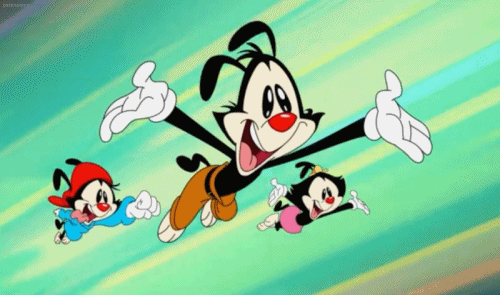
YAKKO WARNER was the easiest to sort. He’s a Snake primary, here for his family, maybe Dr. Scratchansniff, and that’s about it. He’s the oldest, it makes sense. I mean, in Wakko’s Wish he literally gets a promotion to parent. That scene at the beginning where he and Dot are just sitting at the train station, implied to be sleeping there to, as they wait for Wakko to get home-FOR AN ENTIRE YEAR-it’s so soft and easy to forget about with later scenes but it shows how much they love him.
Anyway, Yakko is extremely protective and needs to be around his family. His fear in the IT parody is being alone with no one to talk to him, and his first worry after is he funny is where his siblings have been. Plus, he doesn’t really show a strong preference for the rest of the primaries.
I know that the first thought for the Animaniacs is that he’s a Snake secondary like Bugs Bunny, but remember, they’ve had every secondary as a model/performance ever. Yakko, I believe, is a Bird secondary through and though.
Yakko has the most songs of his siblings, and seeing as a joke in the reboot was that he kept trying to sing his educational songs and he kept getting interrupted-he clearly loves doing them. Yakko’s World, Every Word in the English Dictionary, Time, Multiplication, these are things that he clearly studied for the songs and require extreme memorization (I mean every country in the world and every world in the english language??). He also almost always has his lines memorized, and his sister’s, and probably Wakko’s. Part of his problem with Nicklewise is the fact that no one is acknowledging what he’s saying, and then he’s tongue tied. One of the first things he does when he gets back to the lot is swallow a tablet and learns everything about the past 22 years.
When describing himself in “To be like us” he literally starts it off, “To be like me? Well buddy here’s the key/use the pen not the sword when you’re in a fight.”
When he does just charge in like a Lion he loses. Plus, dad jokes and puns are just a Bird thing. If you have a Bird secondary you are going to have an appreciation for wordplay, trust me I’m a Bird secondary.
DOT WARNER is an actual Snake secondary. She’s the unprepared one. She doesn’t know her lines, and she didn’t practice her song on the first ladies before she sung it, which is how she learns that you cannot give a significant amount of time to each first lady in two minutes-and she didn’t even remember them all.
This exchange is peak Bird v. Snake:
Dot: “It’s a little ditty I’ve composed detailing the accomplishments of the women behind the men...Every single first lady of the United States of America! Please put two minutes on the clock!” Yakko: “Oh, no no no no no. Hold on. You’re going to sing about every First Lady in two minutes? Have you practiced this?” Dot, possibly sarcastic but probably telling the truth: “Well no, I have not.”
She’s also the one who always uses how cute she is to get people to do what she wants. The big scene of Wakko’s Wish is Dot pretending to die so effectively that she fooled everyone but (maybe) Yakko and Wakko, and even made the guy who “killed” her feel remorse for his actions. Also, in the intro she’s described in the original as cute and in the new one as witty-which that combination feels very Snake.
Unlike her brother Dot is a Lion primary. It might be a new addition for the reboot, but if she wasn’t originally a Lion primary I think this is just a case of character progression. In the show she calls out people for being sexist or mansplaining, and (possibly my favorite segment) has her singing about women getting the right to vote. The great thing is that this segment addresses the fact that just because women got the right to vote didn’t mean every woman could vote, because she finds out that as a toon she can’t vote. In less than a day she brings together Looney Toons and Hanna Barbera cartoons to go to Washington and lobby congress for the right to vote. And wins.
Yeah, Dot don’t play around. Also she calls out fear-mongering (Had to fit that in somewhere).
WAKKO WARNER (YES I KNOW HE’S THE MIDDLE CHILD BUT HE HAS THE LONGEST SECTION) was the hardest for me to sort out. Literally of course. He didn’t feel like any of the primaries to me for a while and what I really needed to look at was Wakko’s Wish. In Wakko’s Wish he’s the one telling everyone that they have to keeping hoping for something better and never give up while his siblings seem to be more out for themselves. Wakko’s the one who interacts most with the town as a whole. He gives Plotz a drink of the elixir after Plotz just tried to murder him and his siblings. There’s also a good argument to be made that Wakko wished for the ability to give everyone in the town what they wanted. He didn’t need to wish for a second ha’ penny, but he has it and it helps the town return to prosperity, which is why I rule him as a Badger primary.
You can also notice it in the original series with how he interacts with other people, but we don’t have enough time to talk about that since we still have to talk about his secondary. Fucking hell his secondary. Wakko’s secondary is the hardest to parse out of them all. It’s opposite problem I had with his primary, he fits all of them.
Like I said earlier, they have models for all the secondaries because they’re toons and they have to get into a lot of situations. But there are certain secondaries they favor over others which help you to see what the real secondary there is under all the models and performances. But the problem I ran into with Wakko is he uses all of them at a ready amount!
I first considered that he was a Bird secondary because of his gag bag, or the clown episode with his extremely well thought out ideas on how to torture the poor clown (don’t feel too sorry for him he’s very annoying), and segments like Wakko’s Gizmo. In Wakko’s Gizmo he builds this very overly complicated and super badass device just so he can make a whoopie cushion go off. But that was what tipped me off, it’s a toy. Wakko’s Bird secondary is just a model he has as a toy, something to have fun with (I won’t say he got it from Yakko but he got it from Yakko). Plus, Wakko’s just to intuitive and spontaneous for an actual Bird secondary. The way he uses his gag bag is just in a way where he just understands what to get.
The fact that that he’s very intuitive with his gag bag and impulsive also set me off that he wasn’t a Badger secondary. Of all the secondaries he uses this one the least in the original series. However, interestingly, this is the only secondary he uses in Wakko’s Wish. He works his ass off for a year to make a ha’ penny to pay for Dot’s operation, he makes the wish on the star, he plays sort of a peace maker with the town and others. It’s something he used more specifically for that movie though.
The big debate was whether he was a Snake or a Lion, but-BUT-I’m gonna be kind of controversial and say that he has a Lion secondary. Yes-he’s very situational, but his go to course of action is to hit people with his mallet. Plus, the way he uses his gag bag is he just goes for it, because he feels it. He’s always in the moment, which is how he’s able to use his gag bag. Also, there’s a difference between the way Dot and he usually do things, if they were both Snake secondaries they’d look more similar, but they don’t. And he doesn’t always have what’s needed for the situation, he needs to feel around for it. I could be talked into a Snake secondary but for now I’m pretty happy with Lion.
So...
Yakko Warner - Snake primary/Bird secondary, has all models and performances
Dot Warner - Lion primary/Snake secondary, has all models and performances
Wakko Warner - Badger primary/Lion secondary, has all models and performances (specifically uses his Badger secondary model in Wakko’s Wish, and specifically uses his Bird secondary model as a toy)
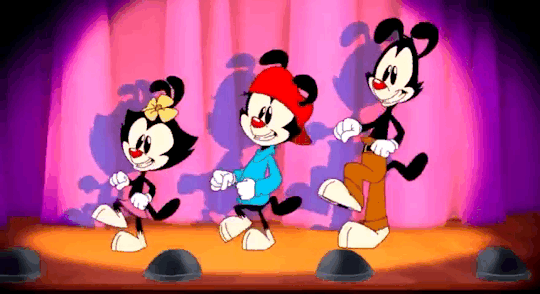
#sorting hat chats#sortinghatchats#yes i really just sorted the animaniacs#dot warner#yakko warner#wakko warner#yakko is my favorite#animaniacs#snake bird#lion snake#badger lion#wakko and marinette stop being so damn complicated challenge
39 notes
·
View notes